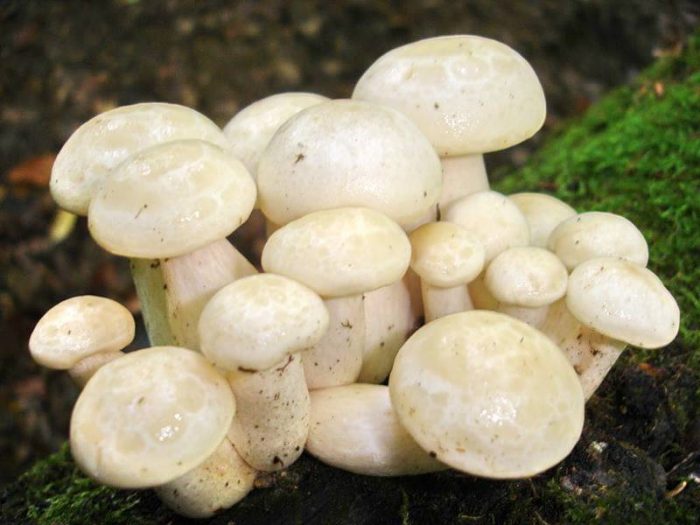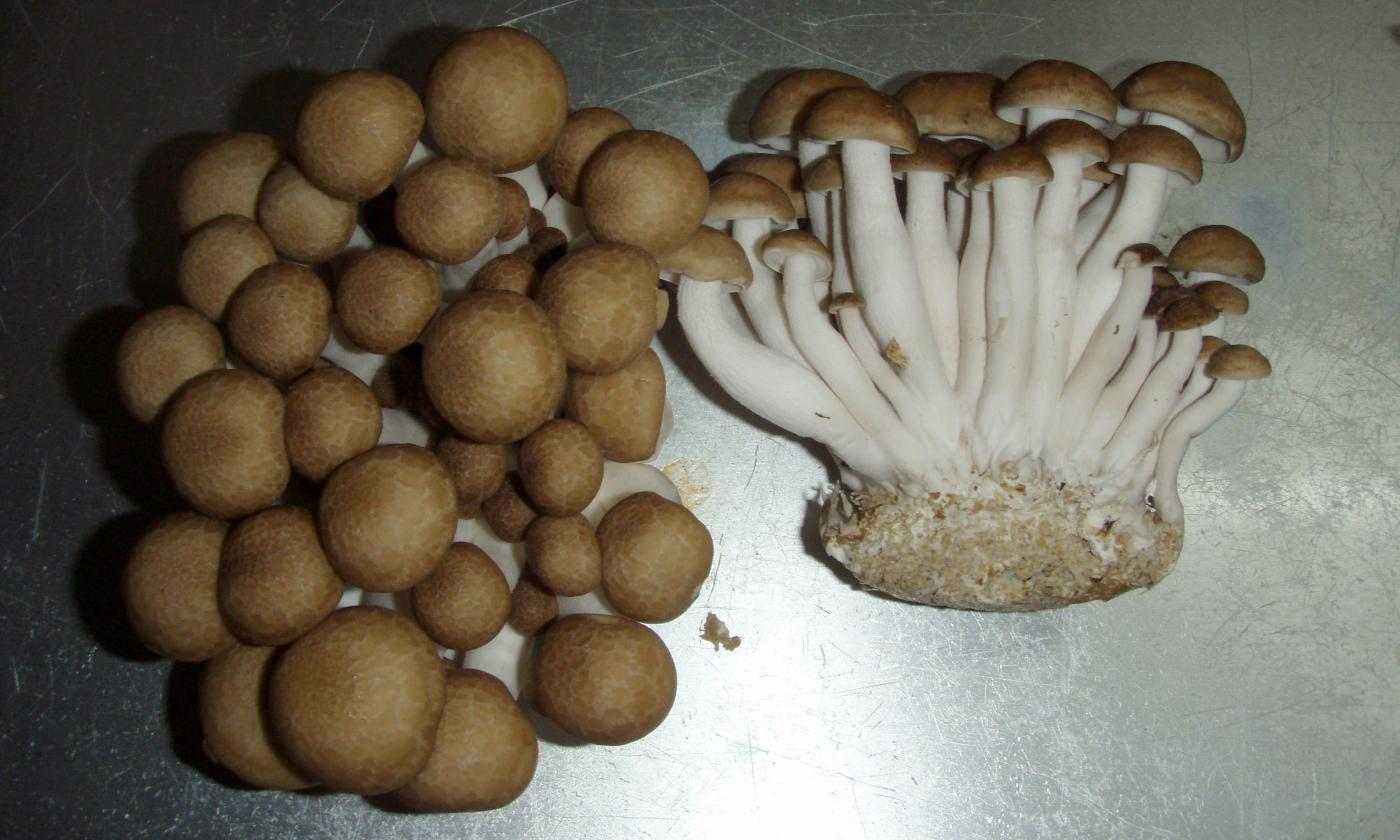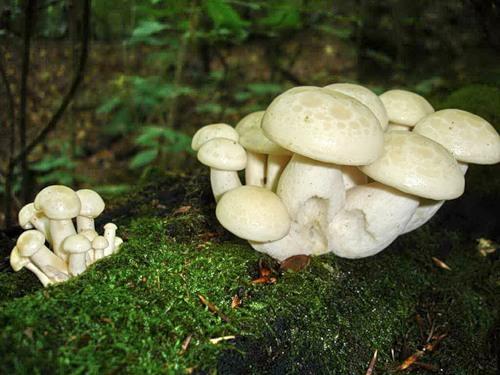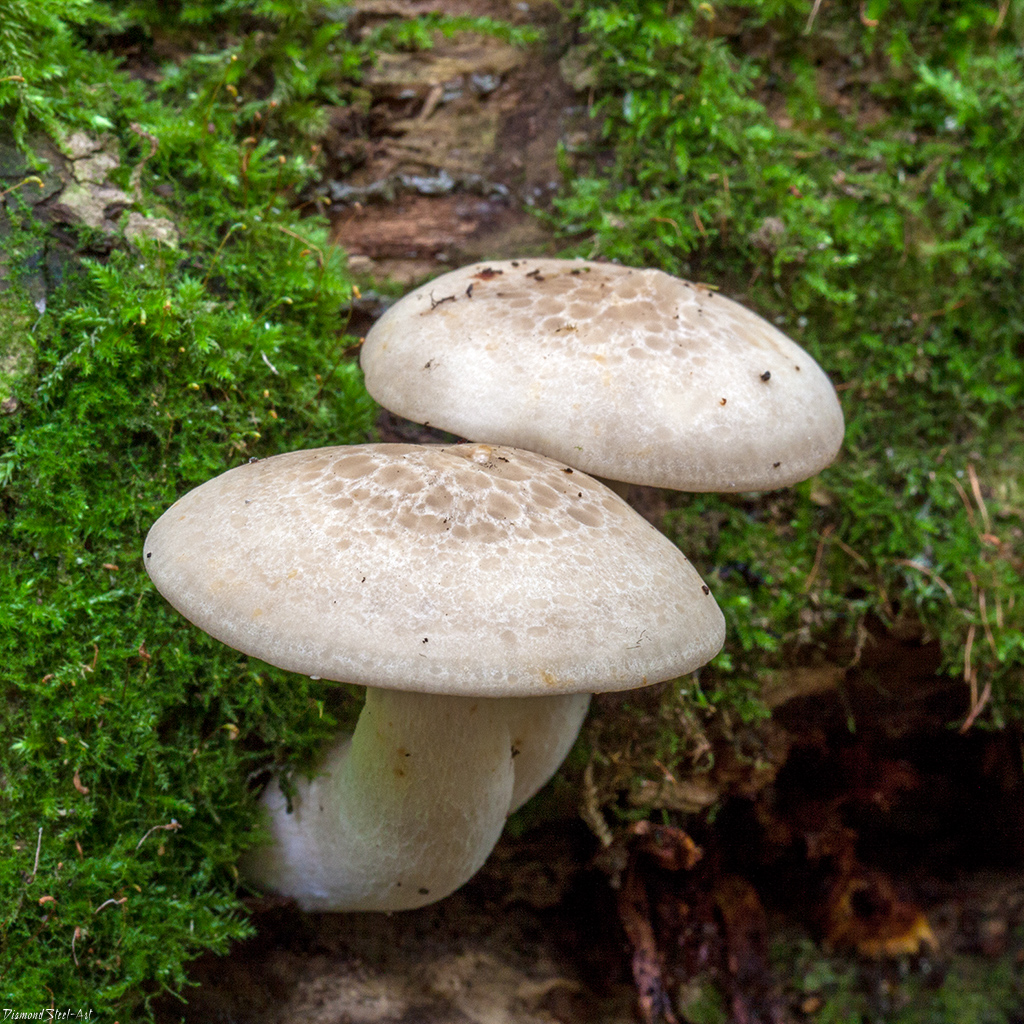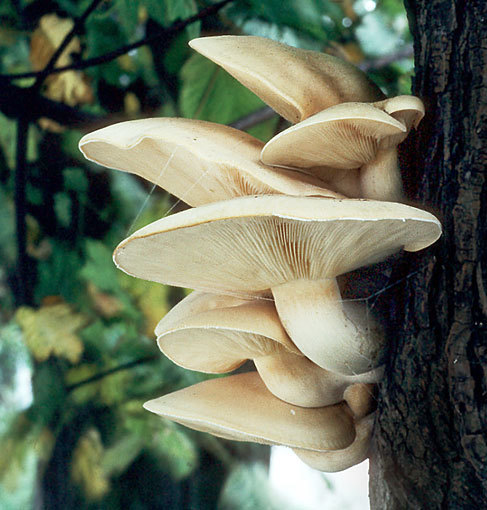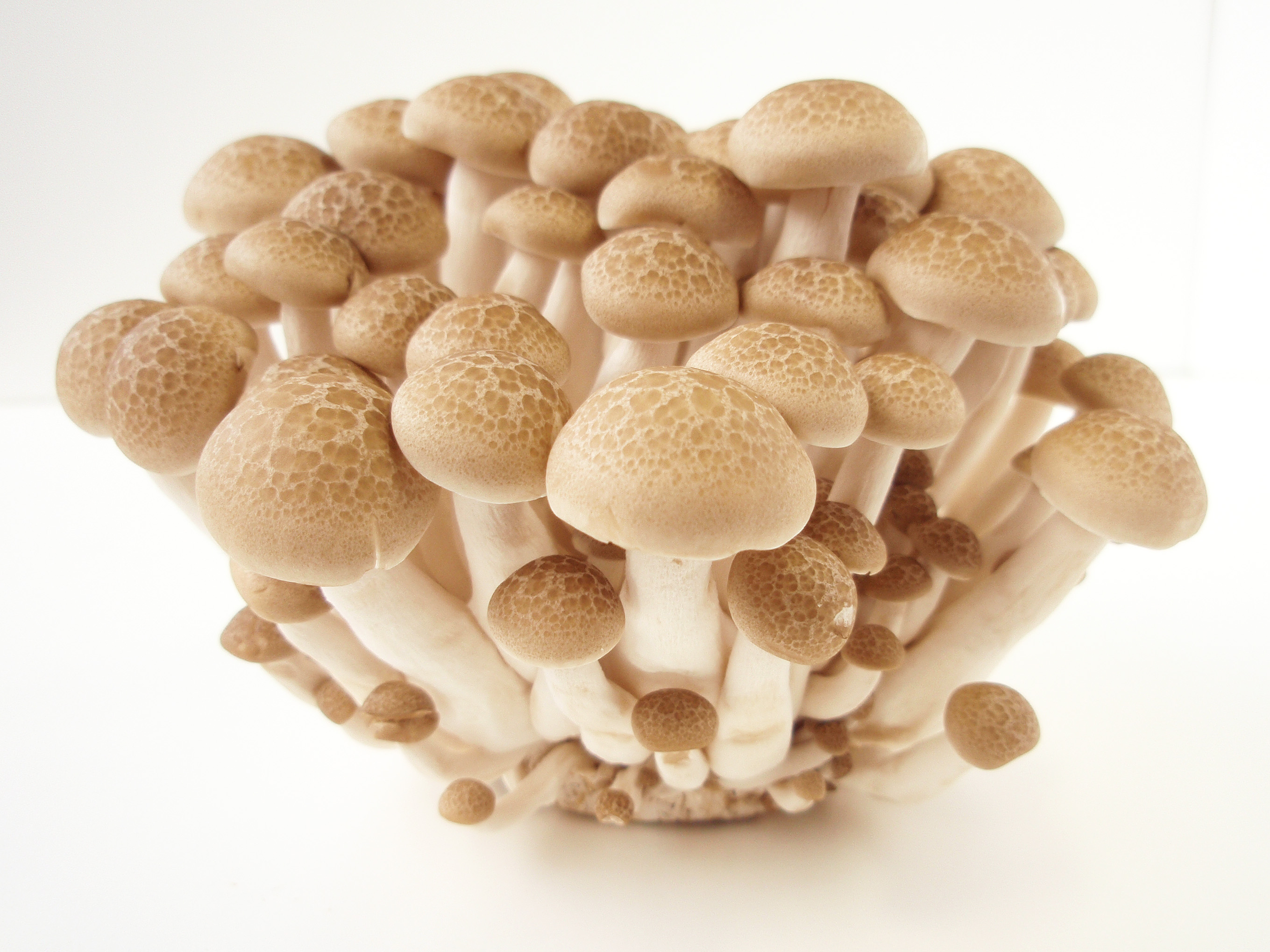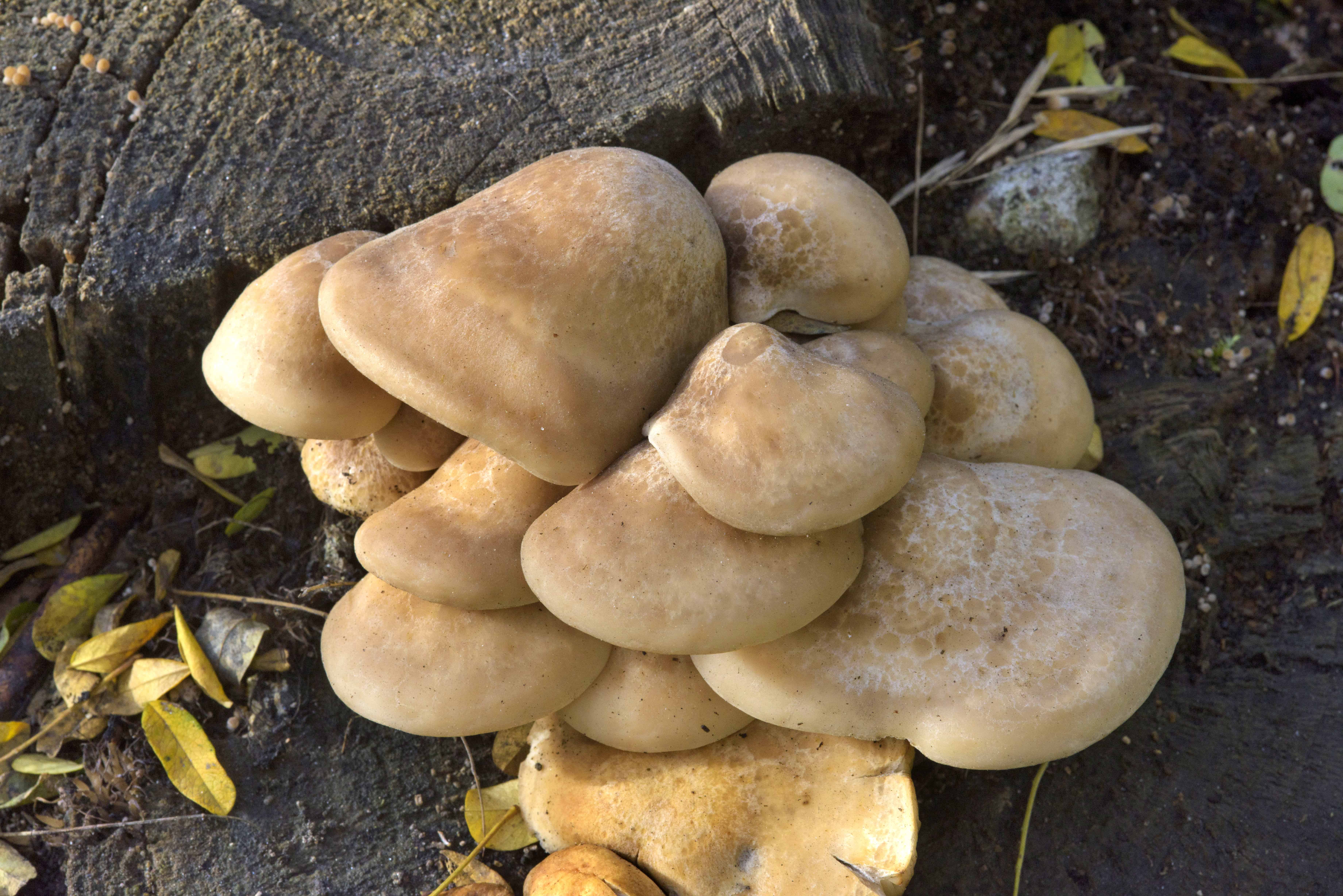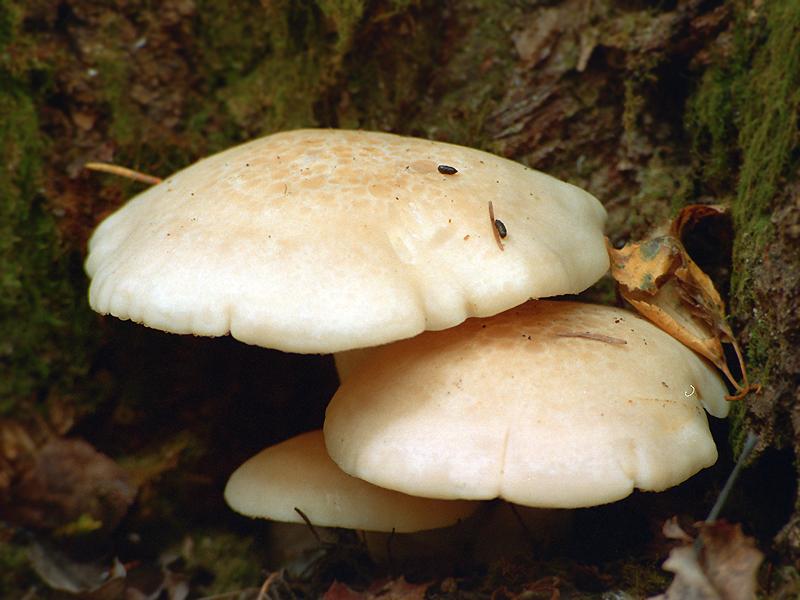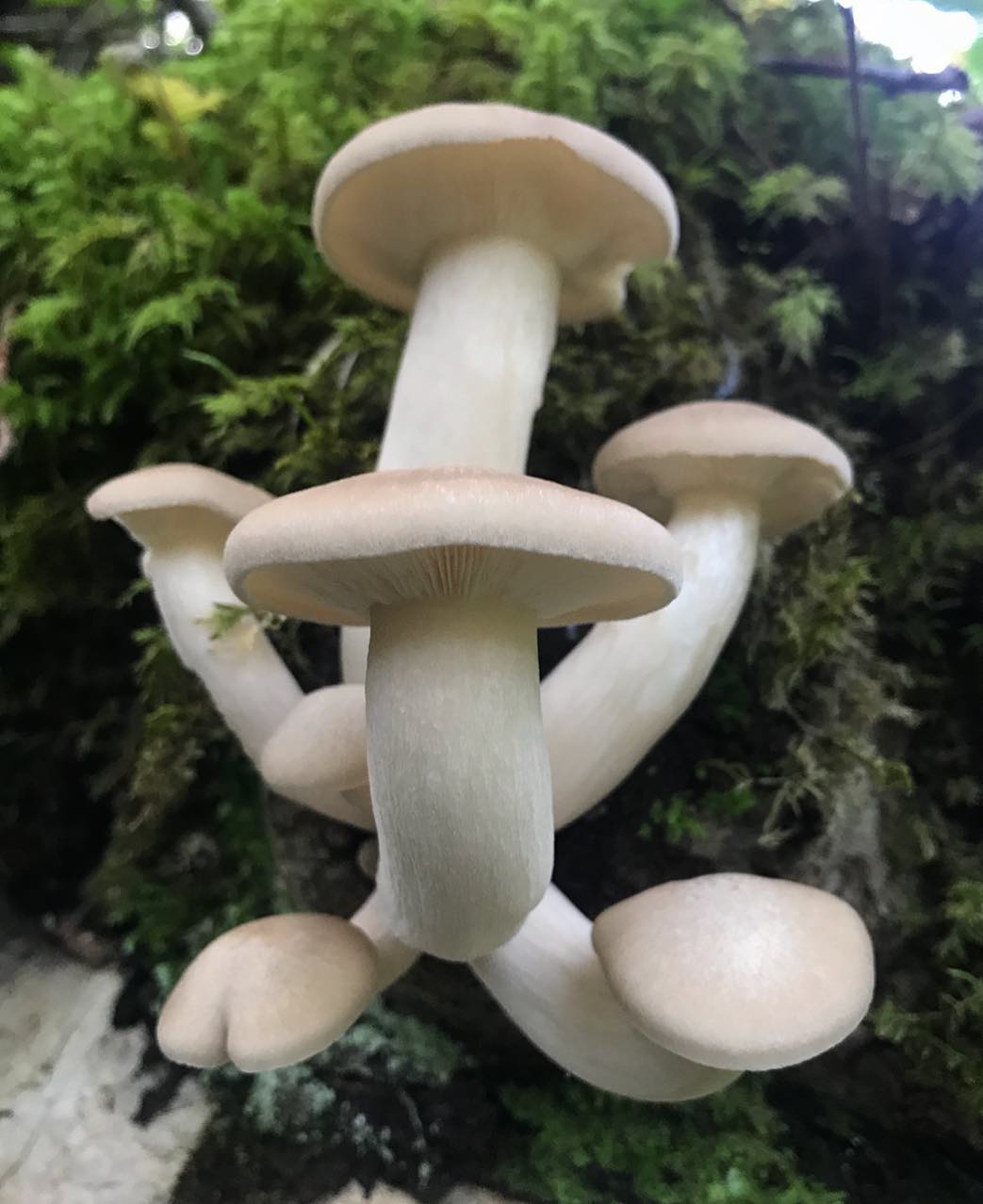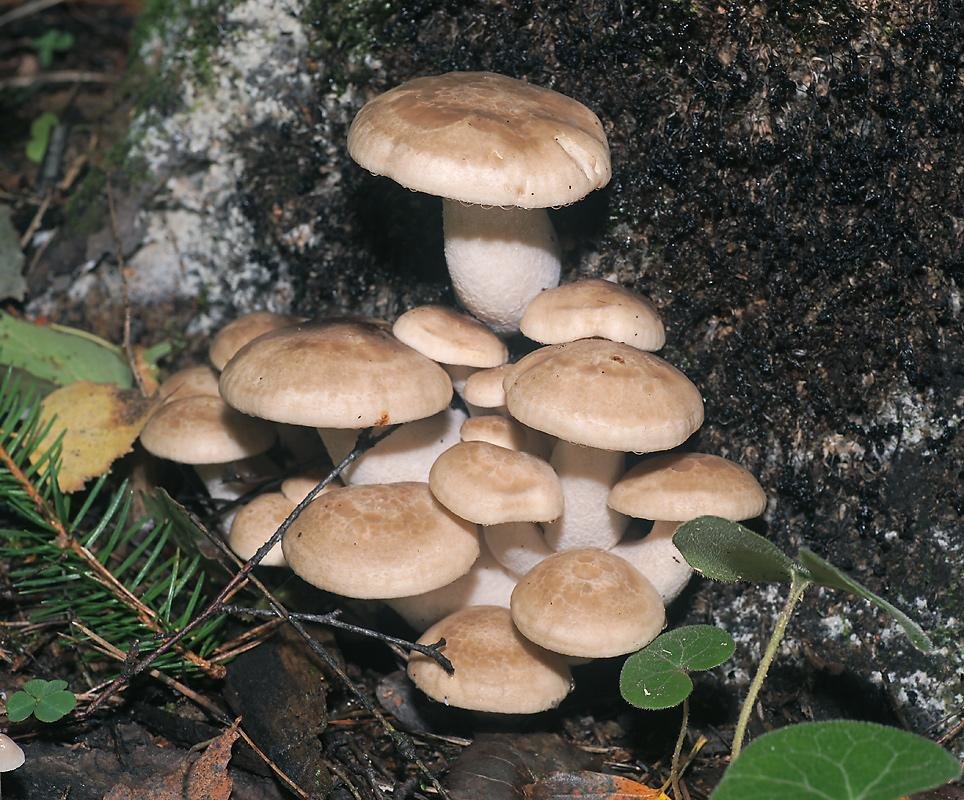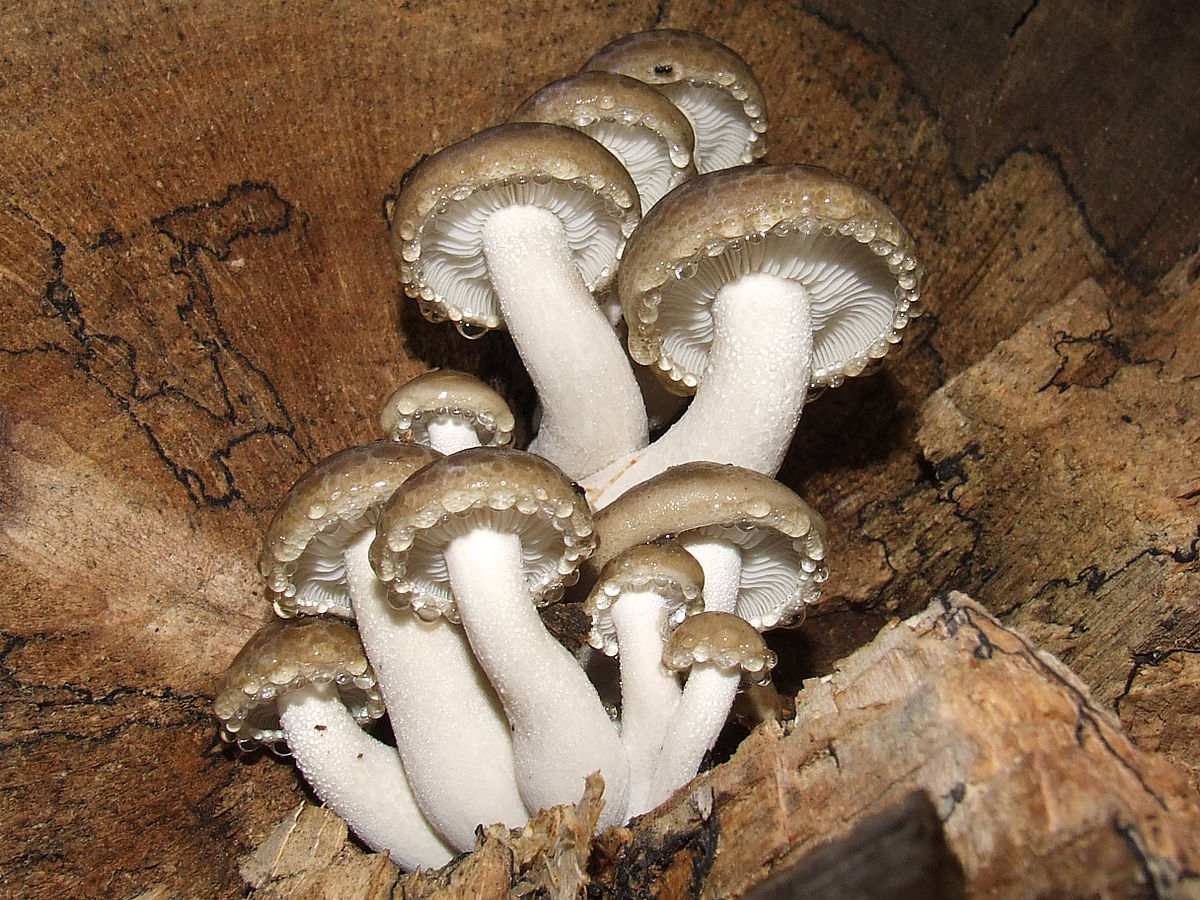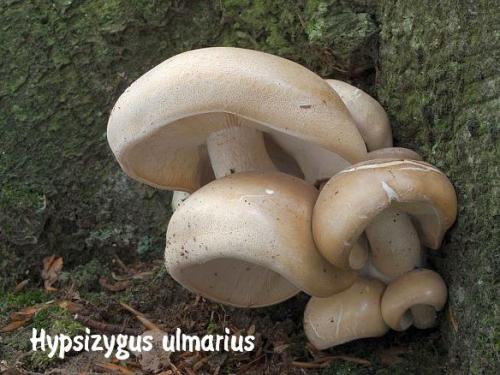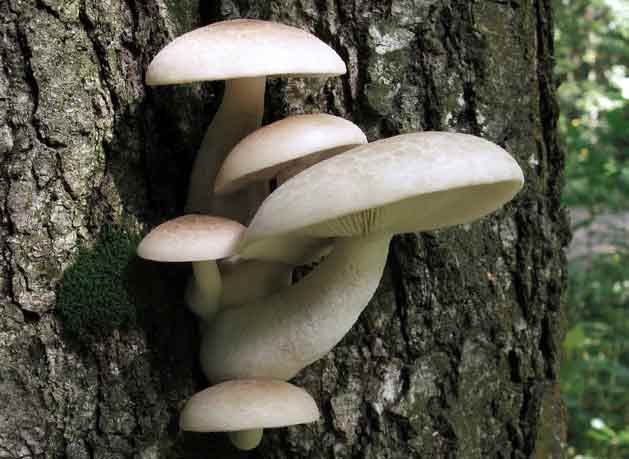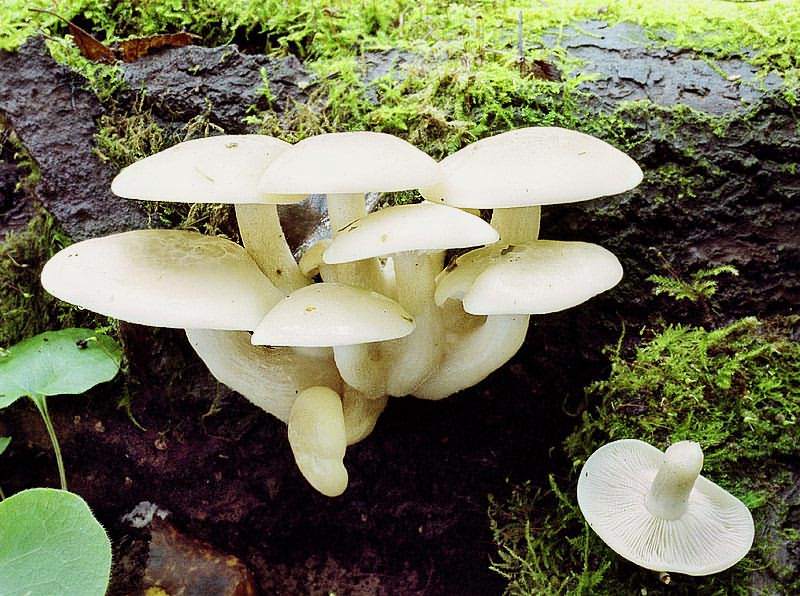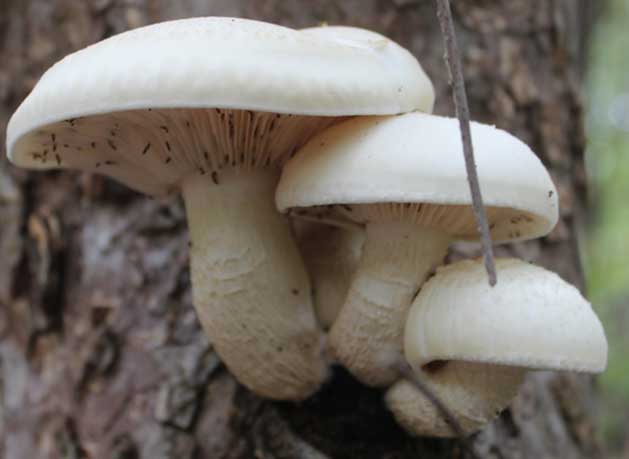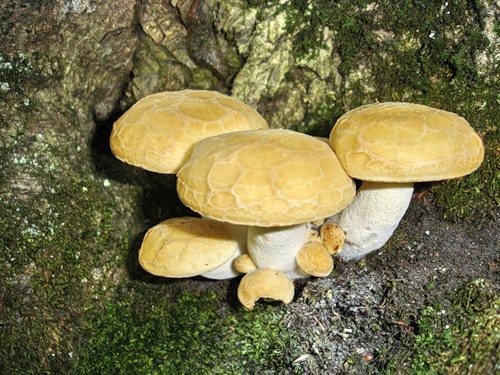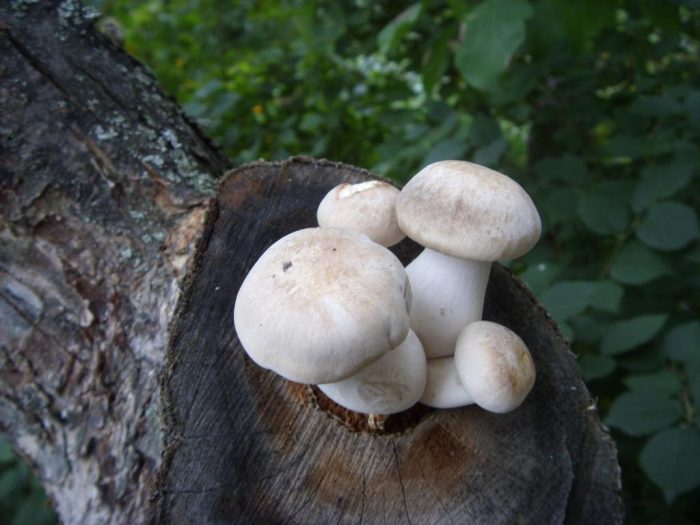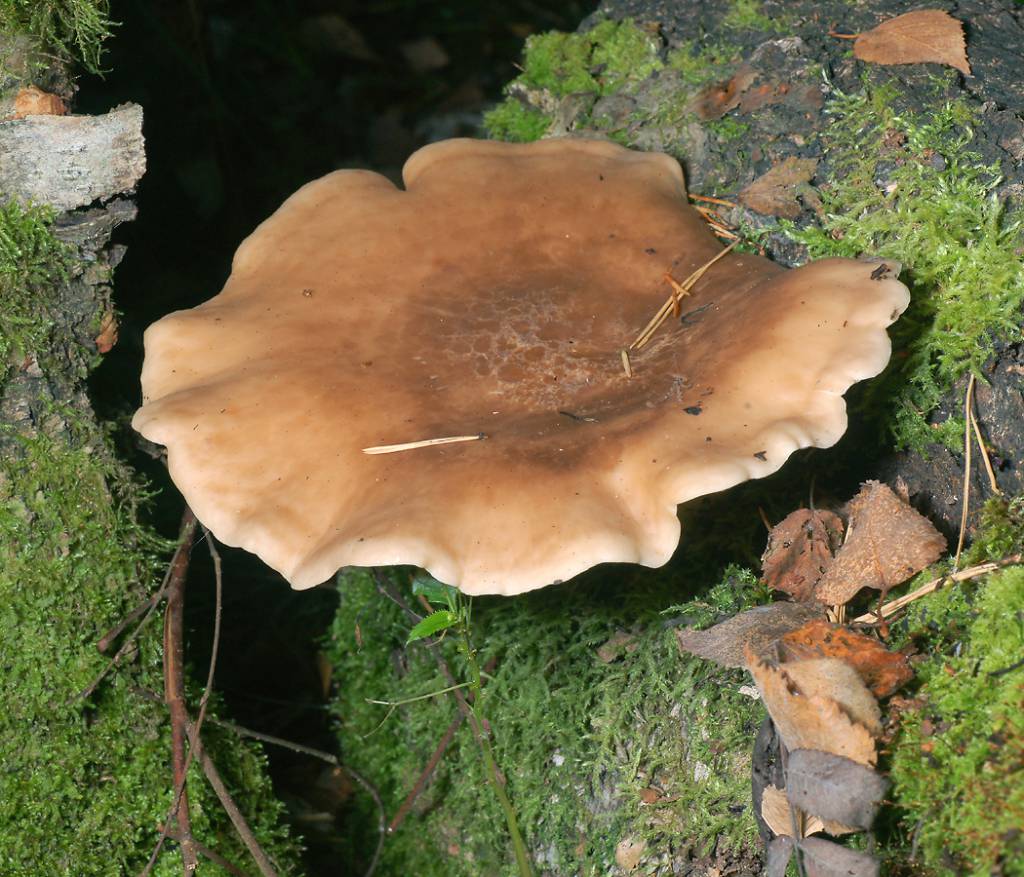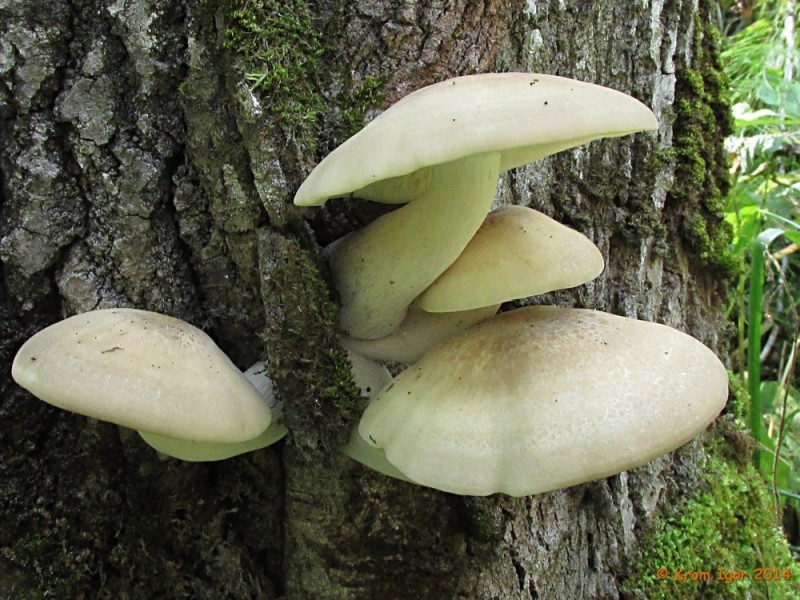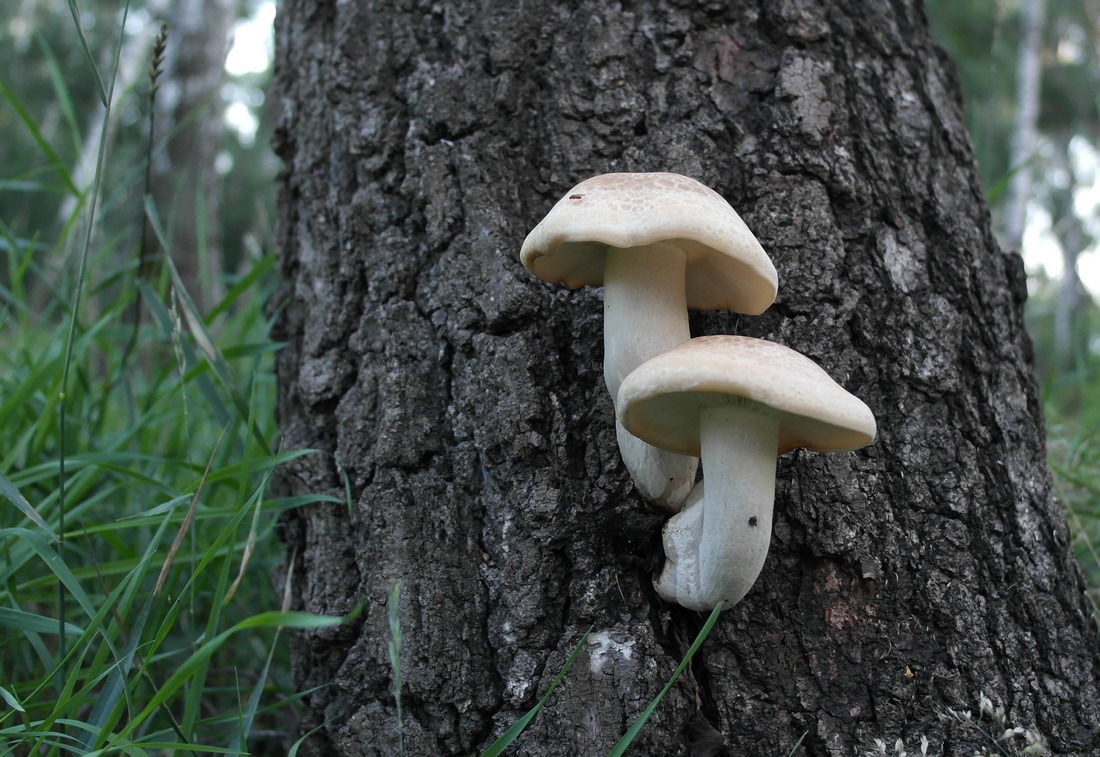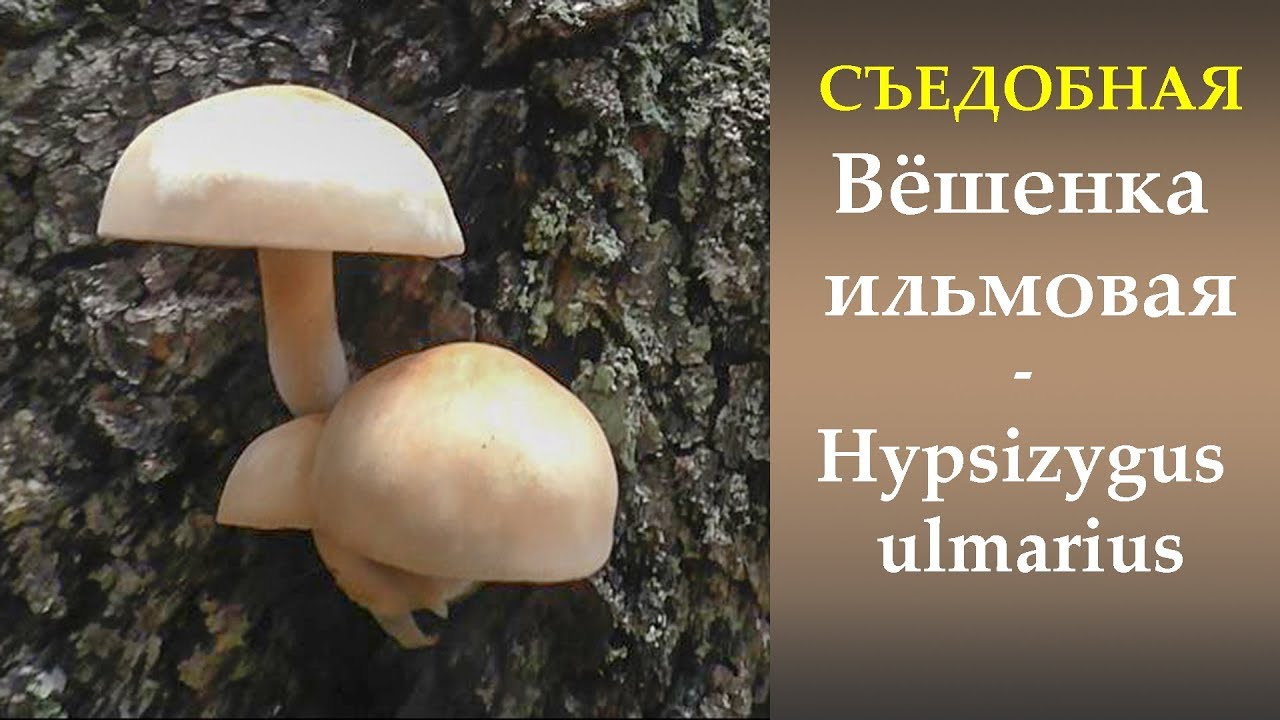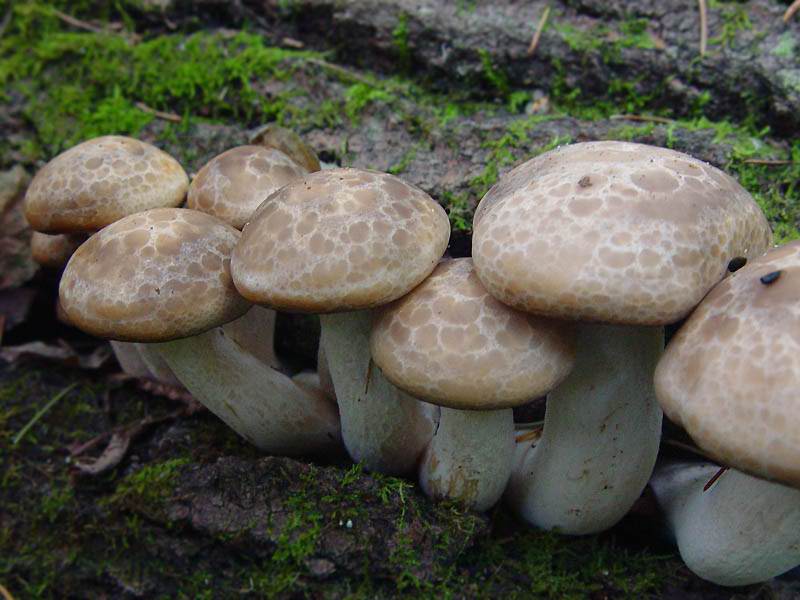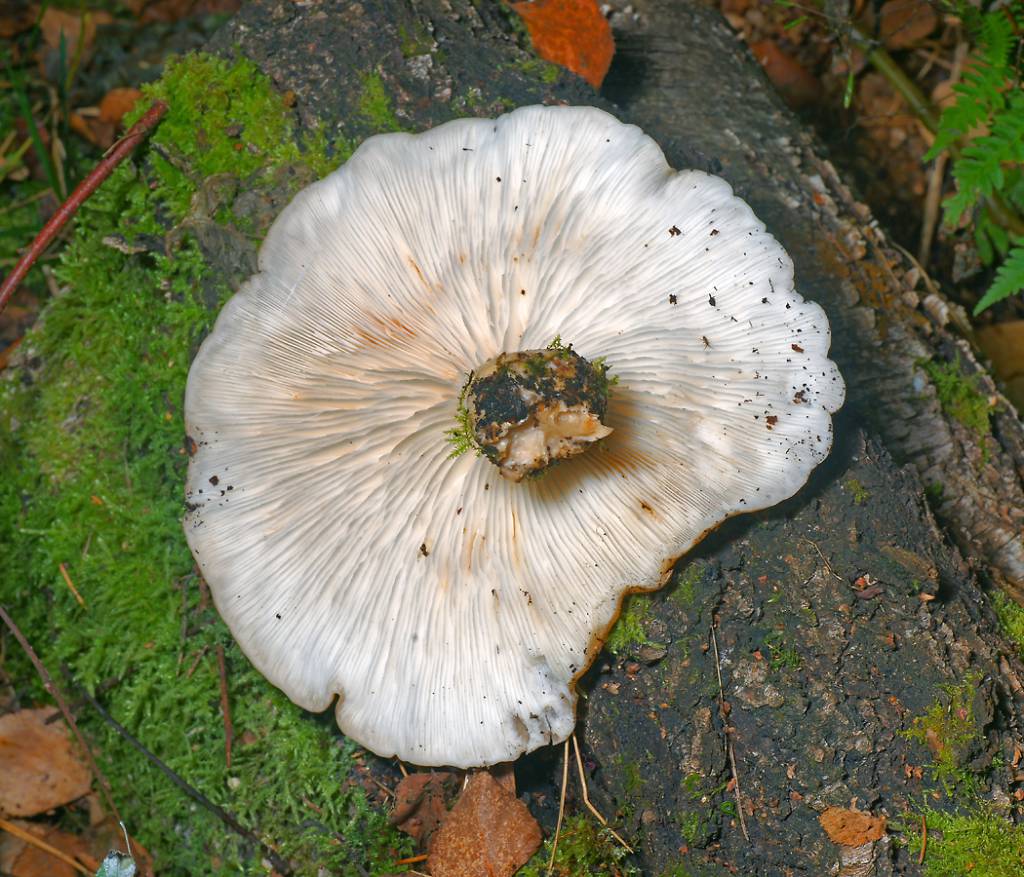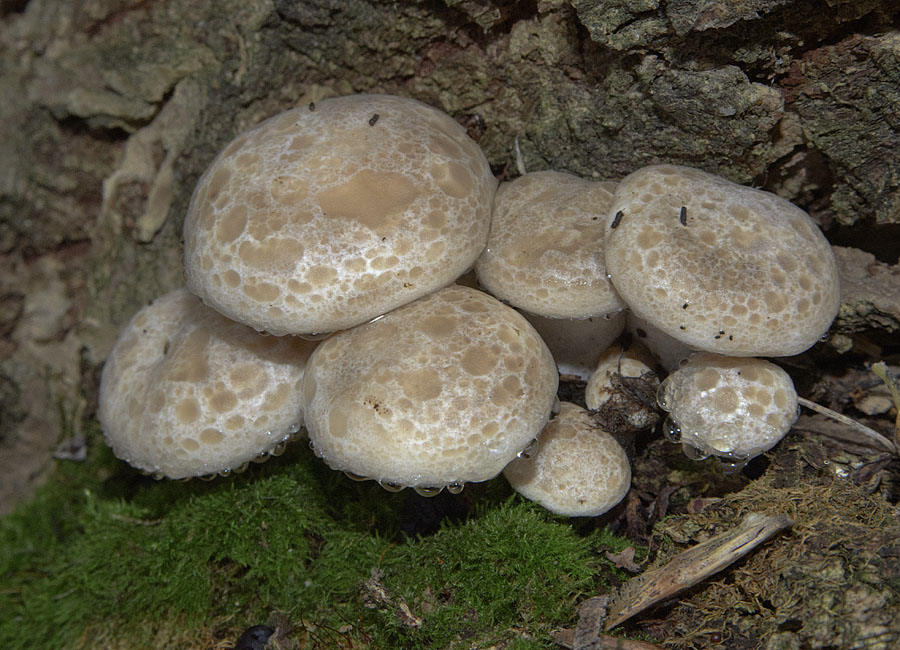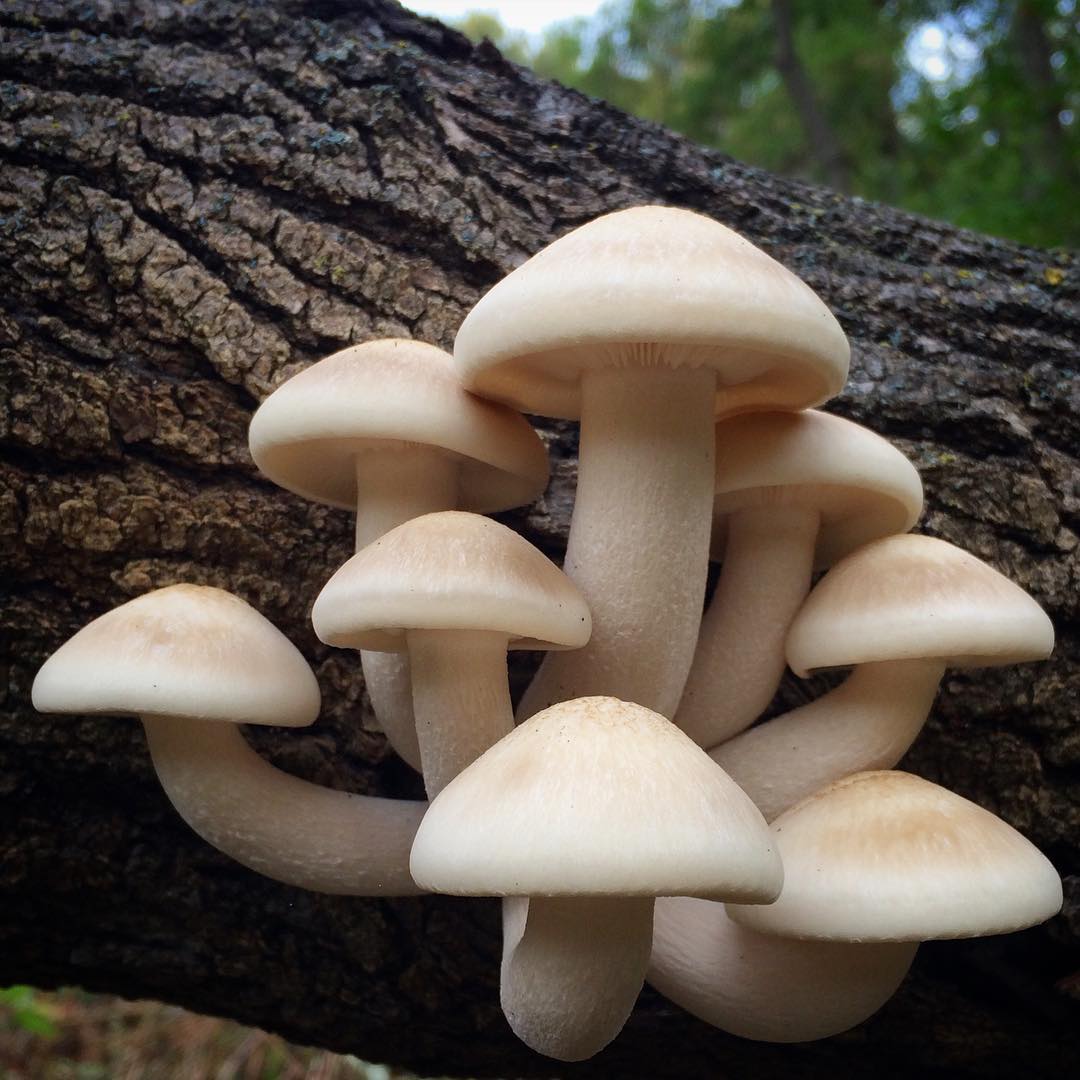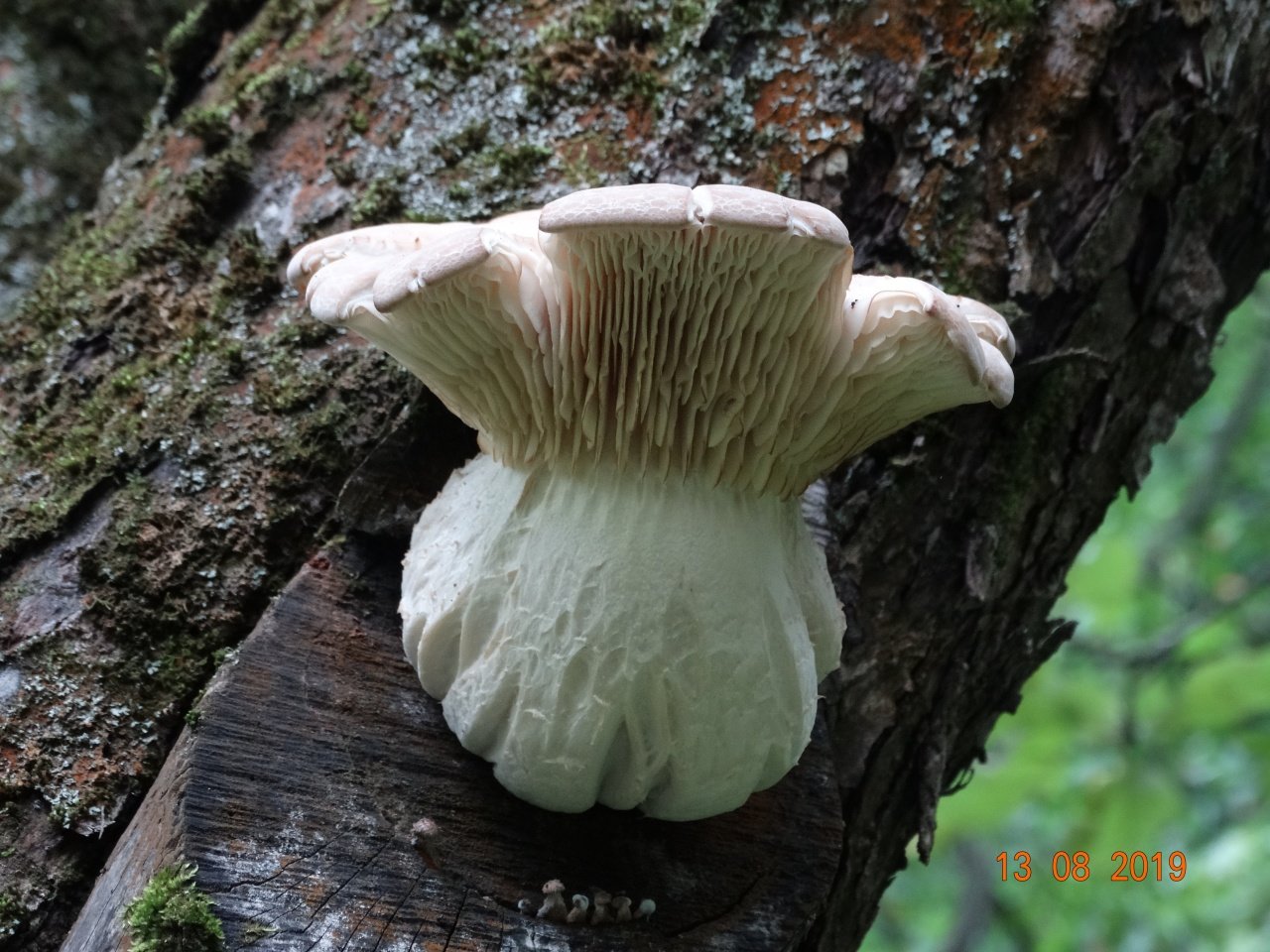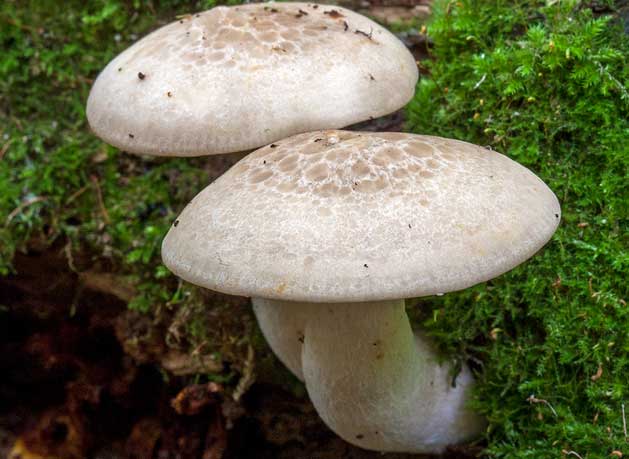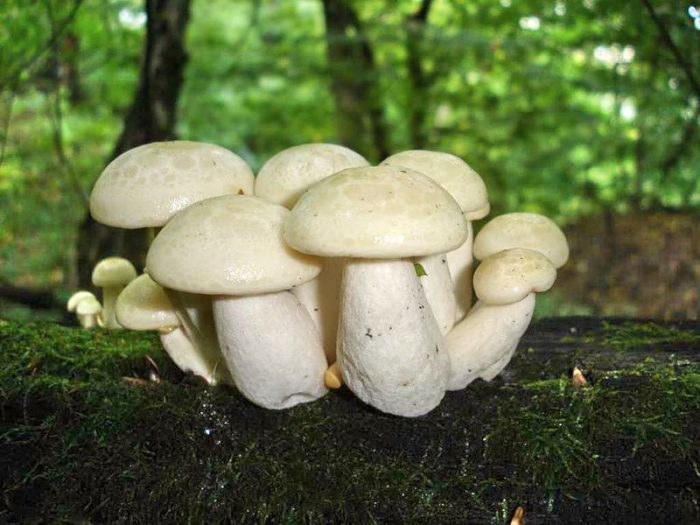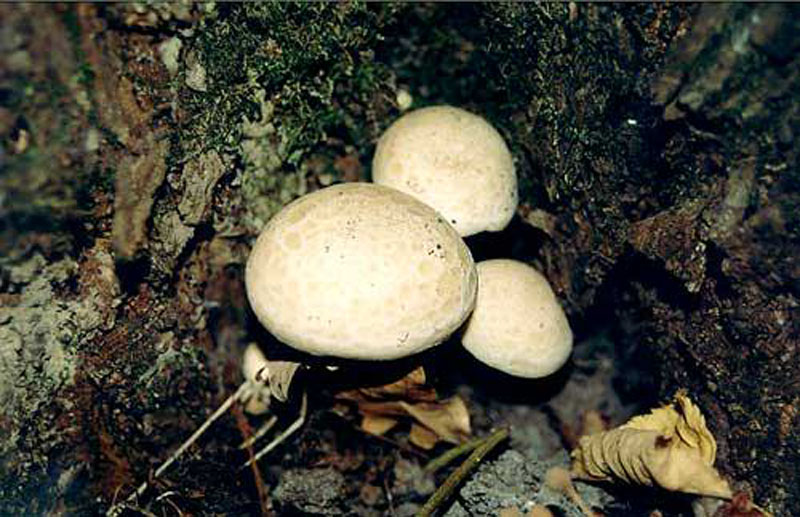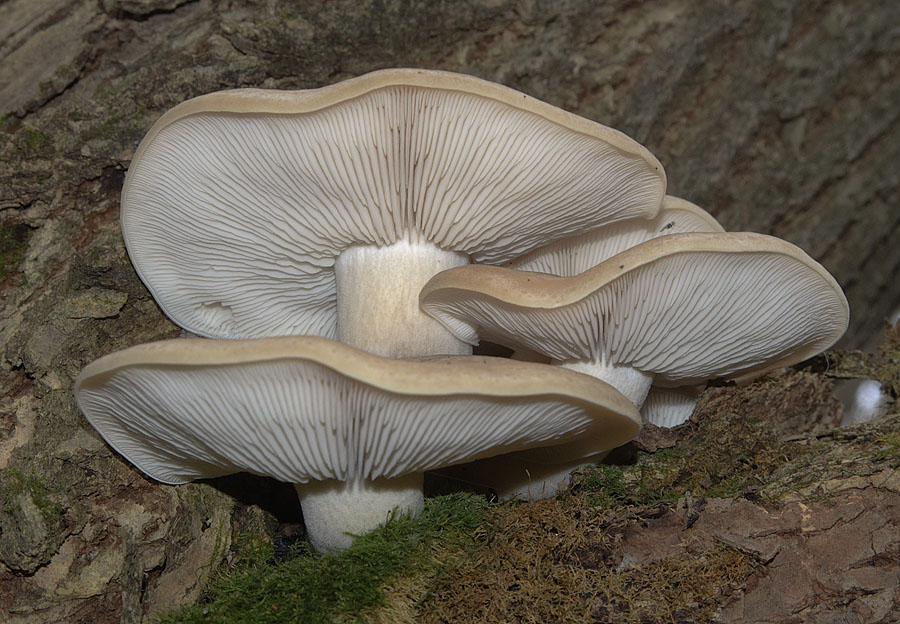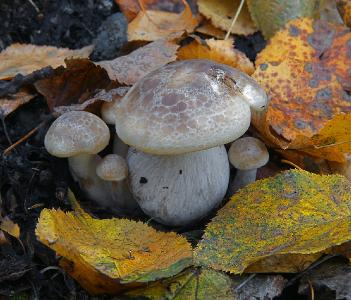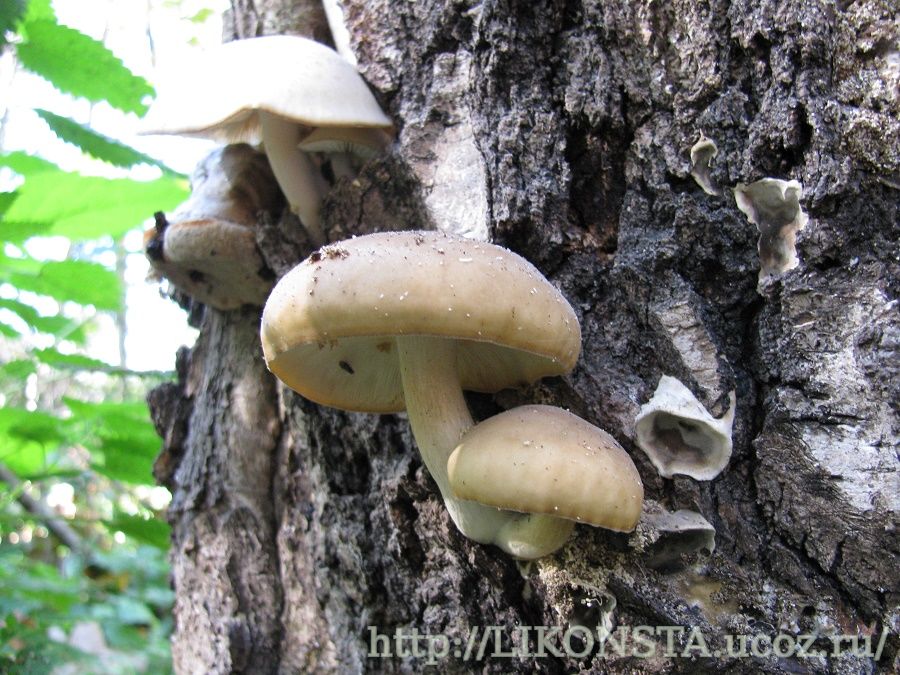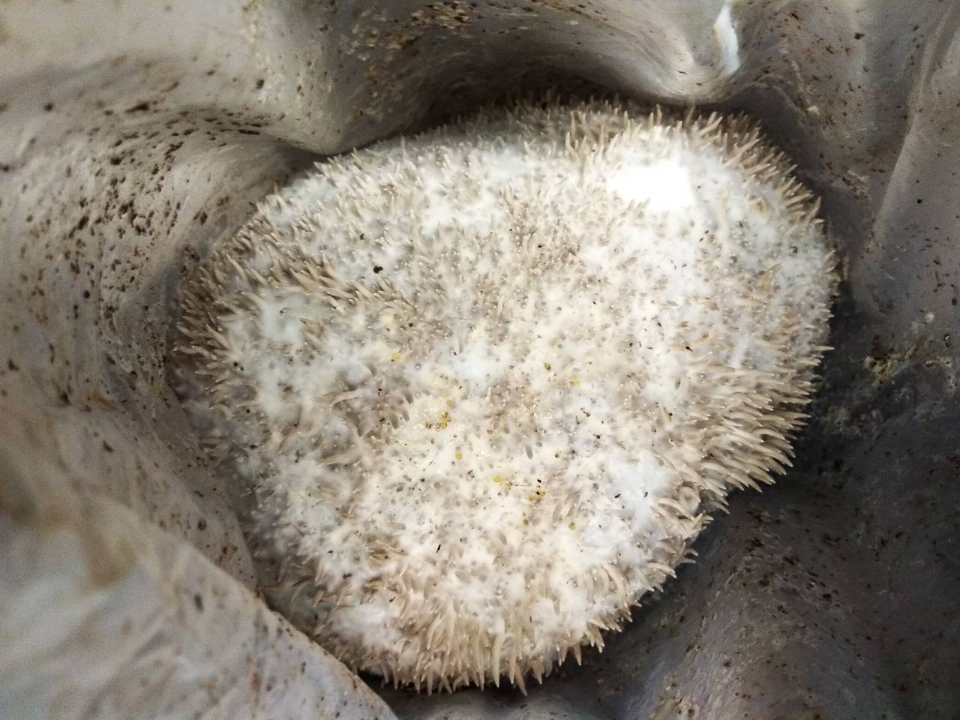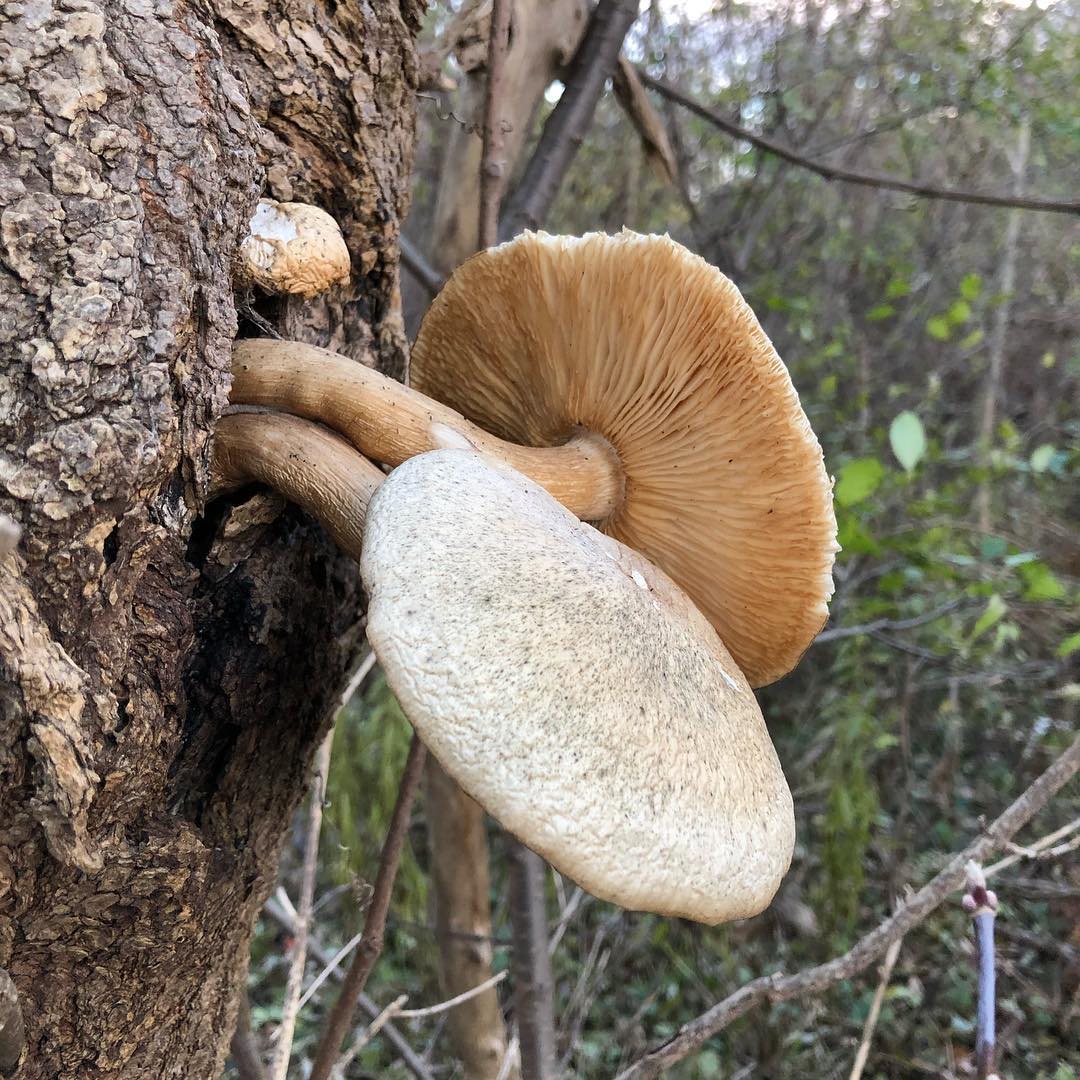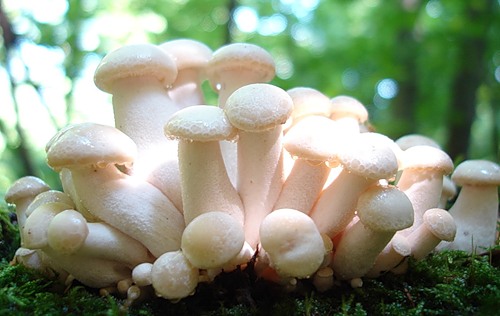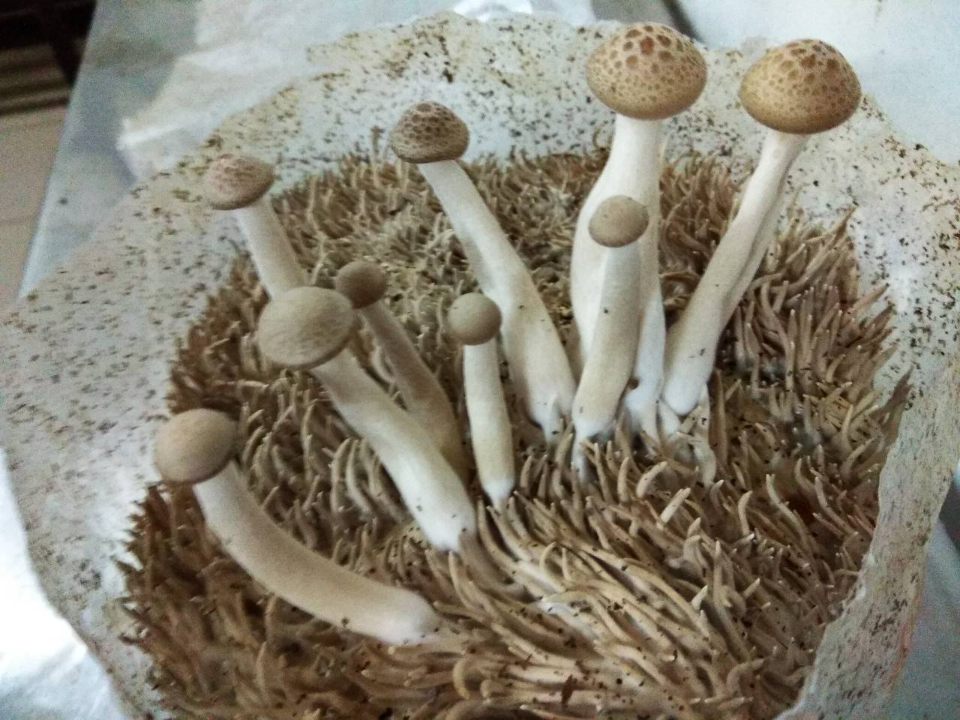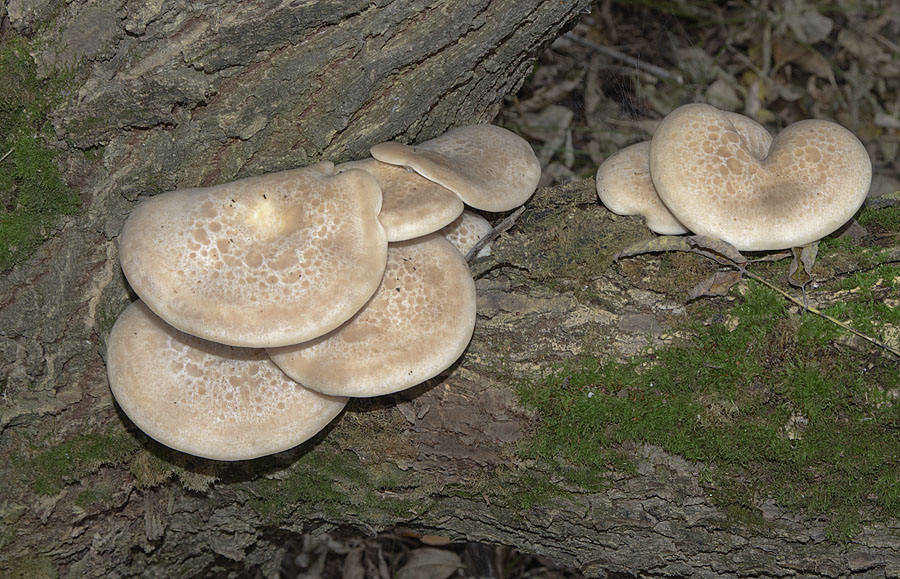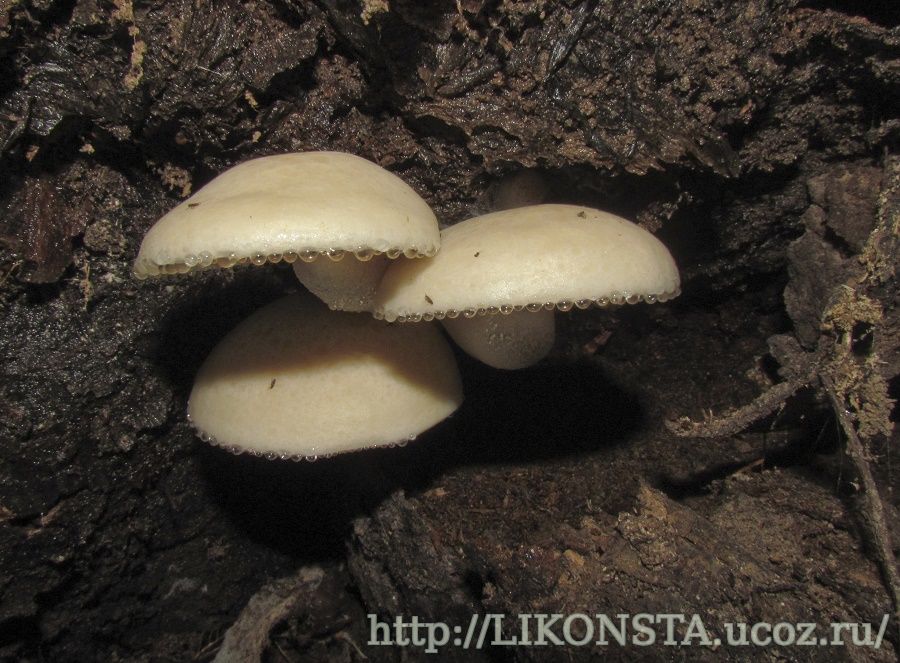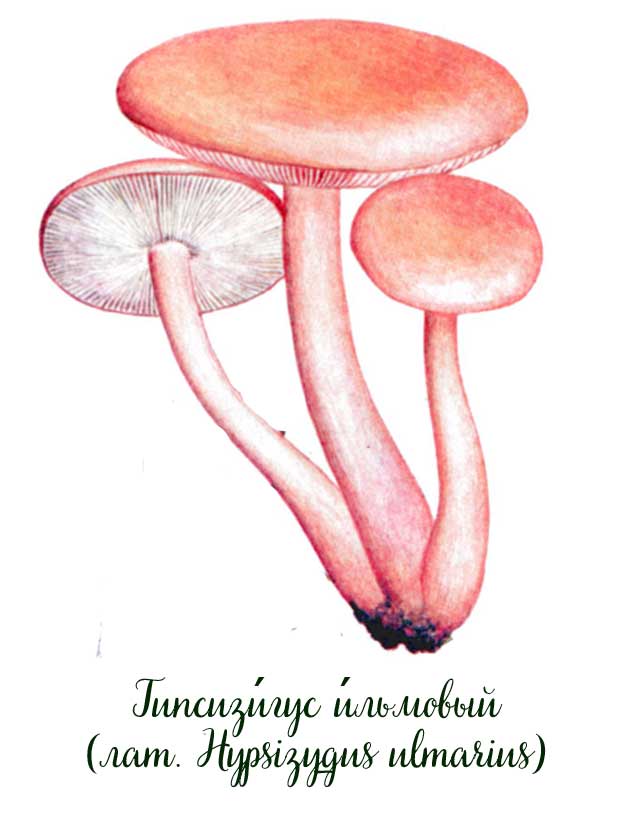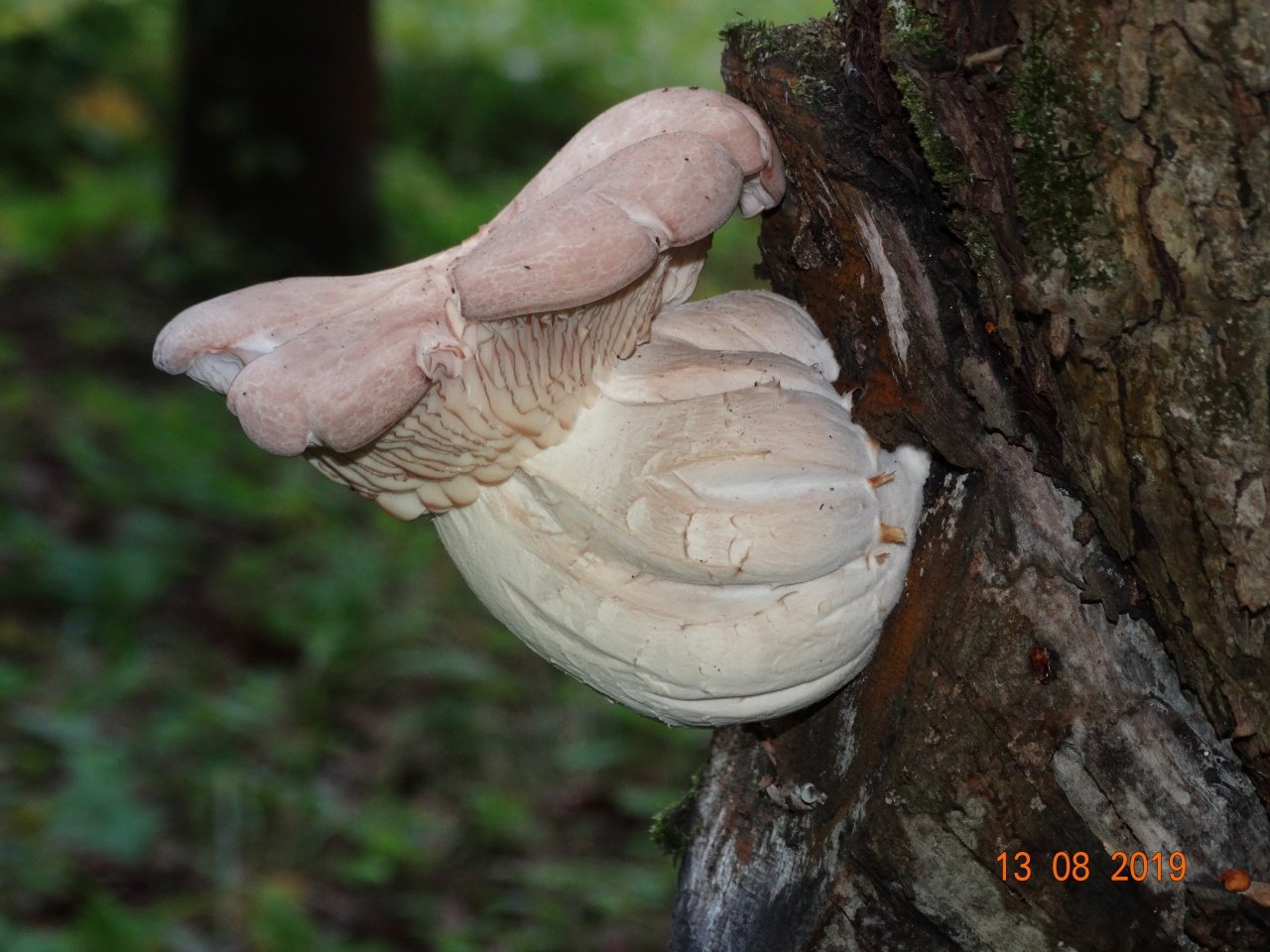Collection rules
It is recommended to collect elm gypsygus in mid-autumn from the second decade of September until frost. You need to look for an edible mushroom in the forests at the roots of trees or directly on old stumps and dead wood. Since the elm ryadovka usually grows in groups, a fairly large harvest of mushrooms can be harvested in one trip.
Like all mushrooms, gypsygus has the ability to absorb toxic substances from soil, wood and air. You need to collect it only in clean places; you cannot cut off the fruit bodies that grow near roads and industrial areas. Even after processing, too many harmful compounds will remain in their pulp.
Hat
The hat is 5 to 8 cm in diameter, but there are quite large individuals - 15 cm.In the beginning, it differs in convexity, tuberosity. The edge of the cap is rolled up, watery brown spots are visible over the entire surface. Further, the shape changes, becomes convex-prostrate, or prostrate, sometimes a blunt tubercle or a slight depression is found. There are eccentric caps, the edges are lowered, drops of liquid hang on the plate, lingering around the edges in wet, humid weather. Painted in yellowish "marble", watery spots, sometimes whitish, pale yellow, slightly yellow, and specimens are found in a pale whitish-brown color.
Description
Gypsizigus elm is distinguished by a characteristic pattern on the cap, which is not found in any other mushrooms. These mushrooms grow on woody substrate in large clusters.
Hat
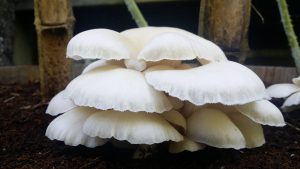 Shape: at a young age, distinctly convex with a tucked edge, becomes unfolded with maturity. The hat is thick and fleshy. Quite large, usually around 10 cm, but can reach 25.
Shape: at a young age, distinctly convex with a tucked edge, becomes unfolded with maturity. The hat is thick and fleshy. Quite large, usually around 10 cm, but can reach 25.
Color: from white to light beige with a specific marble pattern formed by darker spots that resemble drops of water or molten wax.
Dry, velvety.
Leg
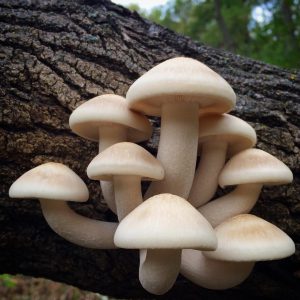 Shape: often curved, thickens downward, grows together with the legs of neighboring specimens, forming large associations. In mature specimens, a cavity may form inside.
Shape: often curved, thickens downward, grows together with the legs of neighboring specimens, forming large associations. In mature specimens, a cavity may form inside.
Size: short and relatively thick (approximately 8 * 2 cm in length in diameter, respectively).
Color: slightly lighter than the hat.
Surface: smooth, downward pubescence can be observed.
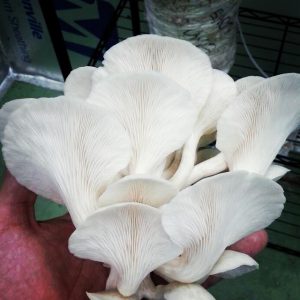 Type: lamellar.
Type: lamellar.
Color: slightly lighter than the cap.
Features: dentate adhesion, frequent, of moderate thickness.
Pulp
Density: dense and elastic, even tough.
Color: white, turns yellow in case of mechanical damage.
Organoleptic characteristics: pleasant mushroom taste, smell - typically "ordinary", mealy with hints of dampness.
Growing at home
Ilmovaya ryadovka belongs to the category of mushrooms that are not only harvested in the forest, but also grown in a home or summer cottage. It is quite simple to do this - you only need to prepare the mycelium of the gypsygus, as well as get a good and healthy deciduous log. Indoors, you can grow a mushroom throughout the year; in the country, planting must be carried out from April to October.
The Ilm row is prepared for planting as follows:
- A birch, aspen or elm log is selected as a nutrient substrate, it should be about 30 cm in diameter, about 50 cm long. or defects.
- For 3 days, the log is kept in water so that the wood reaches the desired moisture level. After the expiration date, the tree is moved for 3-5 days to a dry and well-ventilated place so that excess water comes out of it.
- Using a drill, small depressions about 5-10 cm deep are made in the log, staggered at intervals.
- The prepared mycelium is placed in the drilled holes using thin clean sticks.In order not to infect the seeds of gypsygus with bacteria, sowing should be carried out with gloves, and immediately after planting the mycelium, close the log with plastic bags.
The moistened log with the seeds of the elm row seeded inside is transferred to a shaded, well-ventilated place with a constant temperature of at least 20 ° C. While the mycelium develops, the log needs to be moistened from time to time so that the nutrient medium for the gypsygus is preserved.
It takes about 3 months for the development of the mycelium of the elm row, sometimes more or less. The first crop can be seen six months after planting.

Of course, an elm row at home will not be able to grow for a long time on the same log. Soft logs taken from birch, willow or poplar feed mycelium for about 4 years, on maple, beech and mountain ash logs, a row can grow up to 7 years. After the yields are reduced, the procedure for planting mushroom seeds will need to be repeated.
Attention! Self-cultivation of elm ryadovka allows you not to look for it in the forest, but to collect it in abundance every year right at home. One small log yields a generous yield of up to 6 kg per season
Description of the mushroom
Hypsizigus elm (Latin Hypsizygus ulmarius Lyophyllum ulmarium) is an edible mushroom originating from the genus Hypsizigus. Belongs to the department Basidiomycetes, class Agaricomycetes. He is also known by the names Ryadovka elm, Lyofillum elm.
The diameter of the mushroom cap is 5–10 cm. It looks fleshy and convex. In young oyster mushrooms, the edge is strongly bent and becomes flatter with age. The cap is white (like the plates), watery spots are visible from above.
The leg is 5–8 cm high (rarely 10 cm), widens towards the base, curved. Fibrous, has a whitish coating on top, which turns yellow after touching.
Fruiting body with firm, grayish dense pulp. Fresh oyster mushrooms smell good of dampness.
A bit of history
The mushroom was first discovered in the Far East. It got its name because of its bright color. Ilmovy - because it can often be found on the elm (Far Eastern elm).
Lyophyllum smoky gray, Lyophyllum fumosum
Hat:
From convex, cushion to flat in adulthood, often, in accordance with the growing conditions, irregular in shape, with wavy, oddly curved edges. Due to the same conditions, there is a large variation in size; within one joint, the diameter of the cap can vary from one to seven centimeters. The color is dirty gray, smoky or dull, which is why Lyophyllum fumosum earned its name. The surface is smooth, dry, sometimes covered with small scales, washed away by sediments. The pulp is grayish, moderately elastic, with a weak mushroom smell, without any particular taste.
Hymenophore:
The plates are adherent with a tooth, relatively wide and frequent, in young mushrooms are light cream, later they turn gray.
Spore powder:
White.
Leg:
Smoky lyophyllum bears fruit in large aggregates (single specimens are rare), where legs of different lengths, thicknesses and curvatures form a monolithic “tuber”. The legs are mainly painted in light colors with a predominance of different shades of gray; the surface is smooth, with a powdery coating in dry weather. The pulp of the leg is light, highly fibrous.
Spreading:
Smoky gray lyophyllum is found in dry pine forests, forming mycorrhiza, respectively, with two-pronged pine, from mid-summer to October. Not every year this mushroom is found often, but in good seasons Lyophyllum fumosum can bear fruit surprisingly abundantly, even forming "witch's rings" of massive growths.
Similar species:
According to the views of the science of mycology, Lyophyllum fumosum is included in the complex of “accrete” lyophillums, which differ only in terms of growth and mycorrhiza-forming agent. In this series, one can distinguish a fused row, Lyophyllum connatum, and a crowded row, Lyophyllum decastes. On what basis some species of the genus Lyophyllum in Russian adaptation remain "lyophillums", while others turn into "ryadovki", is unknown to science.
Edibility:
Unlike other "allied" lyophillums, Lyophyllum fumosum is considered a quite good edible fungus, which is obviously associated with not so hard pulp. However, due to the fact that it grows in the most abundant places, it is rarely harvested.
Author's notes:
On dry sand, amid sparse moss and stunted pines, the lush thickets of smoky lyophyllum make some kind of suspicious impression. And, surely, not only on me. Hunters for saffron milk caps and boletus find a clearing densely overgrown with these strange mushrooms, tear off a splicing or two, pick, throw. Tell them that this is a quite decent mushroom in the preparation, they will not believe it and, perhaps, will be offended. It turns out that all the work is in vain.
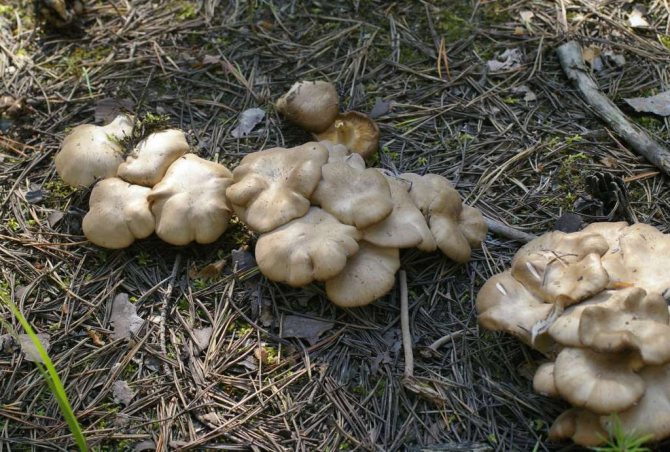
Fragment of the “Great Mushroom Wall”. The entire rampart that crossed the clearing between the pine plantations has not survived. Once it was solid, almost monolithic, but the invasion of the horde of boletus hunters could not be stopped.

It is just that rare moment when the photographer does not feel guilty for the damaged plantings. Someone curious, and not alone, managed, so to speak, to prepare the drug for research. I believe that people who tear and scatter mushrooms they do not need are driven by some kind of high feeling. Even if they themselves do not know it.
Lyophillum elm
It is also grown in the temperate climate of Europe, North America, Australia. There are two types of mushroom: with white and brown fruiting bodies. The pulp of the mushroom is bitter, but when cooked, the bitterness goes away. The finished shimeji has a crunchy texture and a nutty flavor.
An edible mushroom that looks like elm lyophyllum. His hat is brown; in mature mushrooms, it cracks. The shape of the cap is round, the surface is dry. The pulp is white. The leg is long, clavate. Mycorrhiza forms with fir, oak and pine.
Search form
Fruiting from September to October. Due to the characteristic watery-waxy spots on the cap, elm lyophyllum differs from other types of fungi, and similar inedible or poisonous species have not been described for it. At home, elm lyophillum is grown from mycelium.
For planting it, logs of birch, elm, elm, aspen are prepared, no younger than 5 years old, about 30 cm in diameter, about 0.5 m long. The logs should be free of branches, rot and other flaws. Favorable period for sowing the mushroom: from April to October. The logs are soaked in water for days until the desired degree of moisture is obtained.
Briefly about the main
After removing the logs from the water, the excess liquid is removed from them by keeping them for several days in a well-ventilated area. In the logs prepared in this way, small holes 1 cm in diameter and cm deep are drilled with a drill.
They are staggered at a distance of 20 cm from each other. Then, with cleanly washed hands or with gloves, special sticks with mycelium are placed into these holes. Further, the logs are packed in plastic bags, which prevents their infection and accelerates the development and growth of mycelium.
The entire period of development of mycelium monitors the moisture content of the logs. After a month, the mycelium completely fills the substrate. And six months later, the first harvest appears.
The fruiting time depends on the hardness of the wood of the logs. For example, on soft woods, poplar, willow or birch, mushrooms are harvested for about four years. Hard varieties such as maple, mountain ash, beech bear fruit over the years.
Elm oyster mushroom (Hypsizygus ulmarius)
Current title
| Index Fungorum | Hypsizygus ulmarius (Bull.) Redhead |
| MycoBank | Hypsizygus ulmarius (Bulliard) Redhead |
Systematic position
Fungi, Basidiomycota, Agaricomycetes, Agaricales, Lyophyllaceae, Hypsizygus
Etymology of the species epithet
Ulmarius, a, um, elm, elm. From ulmus, i, m, elm + -arius, a, um, ratio. Also Ulmus, Elm (genus name).
Synonyms
- Agaricus ulmarius Bull., Herb. Fr. (Paris) 11: tab. 510 (1791)
- Pleuropus ulmarius (Bull.) Gray, Nat. Arr. Brit. Pl. (London) 1: 615 (1821)
- Pleurotus ulmarius (Bull.) P. Kumm., Führ. Pilzk. (Zerbst): 105 (1871)
- Dendrosarcus ulmarius (Bull.) Kuntze, Revis. gen. pl. (Leipzig) 3 (2): 464 (1898)
- Micromphale ulmarium (Bull.) Murrill, N. Amer. Fl. (New York) 9 (5): 307 (1916)
- Lyophyllum ulmarium (Bull.) Kühner, Contribution a l'Etude de Quelques Aspergilles 7: 211 (1938)
- Dendrosarcus coriipellis (Fr.) Kuntze, Revis. gen. pl. (Leipzig) 3 (2): 463 (1898)
Other names: Elm lyophyllum.
Habit
Fruit body: Cap and stem (agaricoid)
Hymenophore: Lamellar (including folded or with rudimentary plates)
Hat
A hat with a diameter of 50 - 80 (150) mm, at first convex, with a curled edge, hygrophane with numerous round watery brownish spots, then convex-prostrate, prostrate, sometimes with a blunt tubercle or slightly depressed, sometimes eccentric, with a curved edge, often with drops liquids on the plates or along the edge, in general, rather light: whitish, pale yellow, brownish-gray.
The plates are frequent, wide, widely accreted, white or yellowish.
Leg
Stem 50 - 80 (100) mm long, 10 - 15 mm in diameter, central or slightly eccentric, sometimes curved, widened towards the base, slightly swollen, longitudinally fibrous, sometimes pubescent at the base, inside or with a cavity, whitish, pale fawn, with a whitish bloom, turns yellow from touch.
Pulp
The pulp is very dense, elastic, fibrous in the stem, watery, grayish or yellowish, with a damp smell.
Microscopy
Spores 4 - 6 × 5 - 6 μm, almost spherical or broadly ellipsoid, hyaline, not amyloid, cyanophilic.
Basidia 18 - 25 × 4.5 - 6 µm, clavate, with a clearly visible central constriction, 2- and 4-spore, with a buckle at the base; cytoplasm with siderophilic granules.
Cystyds are absent.
Pileipellis consists of cylindrical hyaline hyphae with buckles, 4 - 8 µm in diameter.
Hyphae 2 - 8 microns in diameter, with buckles; in the mediostratus, the plates are located parallel, in the subhymenium, rather irregularly located, densely packed, thin-walled, inlaid, 2–4 µm in diameter; in pulp with slightly thickened walls, 4 - 8 µm in diameter, freely located.
Ecology and distribution
- Substance: Woody plants (living trees, bark and dead wood)
- Substrate: Soil, litter
In deciduous and mixed forests, parks, on stumps, deadwood and at the base of living deciduous trees (aspen, birch, elm), in small intergrowths, rarely singly, infrequently.
In Western Siberia, it was noted in the vicinity of Akademgorodok, where it is sometimes found on aspen and birch wood.
Fruiting
From early September to mid-October.
JanFebMarAprMayJun
JulAugSenOctNoveDec
The divisions correspond to the decades of the month.
Nutritional properties
Edible
Similar species
- Crowded lyophillum (Lyophyllum decastes) is distinguished by the growth of larger intergrowths not on wood, but on the soil, by the absence of pronounced watery spots on the cap. Two similar and closely related species of lyophillum - smoky gray lyophillum L. fumosum and hon-simeji L. shimeji grow on soil in pine forests.
- Checkered oyster mushroom (Hypsizygus tessulatus) is an outwardly almost indistinguishable species from East Asia (which in itself does not exclude the possibility of its growth in the forests of Western Siberia). Widely cultivated, it is known in Japanese cuisine as buna-shimeji.
- Another species that we have not yet been able to identify, similar to the elm oyster mushroom habit, elastic white pulp and ecology, is sometimes found on fallen deciduous trees in the old-growth mixed taiga forests of the Khanty-Mansi Autonomous Okrug — Yugra. As a rule, this mushroom grows singly, is lighter in color, and the base of the stem is distinctly pubescent. One of the samples we collected was very bitter, while others were less bitter. Perhaps this is not yet a described species, close to the elm oyster mushroom.
Row elm (gypsygus elm): what it looks like, where it grows, is it possible to eat
Elm hypsizigus, elm lyophyllum, elm oyster mushroom (Hypsizygus ulmarius (Bull.) Redhead, 1984)

Insert-mushroom-tree Synonyms: Agaricus ulmarius Bull., 1791 Pleuropus ulmarius (Bull.) Gray, 1821 Pleuropus ulmarius (Bull.) Gray, 1821 Pleurotus ulmarius (Bull.) P. Kumm., 1871 Dendrosarcus ulmarius (Bull.) Ulmar98 ( Bull.) Murrill, 1916 Hypsizygus ulmarius (Bull.) Redhead, 1984
Etymology: Lyophyllum (Greek lyo - to dissolve, destroy; Greek phyllis - leaf) ulmarium (Latin ulmarium - elm).
Hat: up to 20 cm in diameter and more, convex, then prostrate, with a straight or drooping edge, often fissured, especially with age, almost white or buffy-yellow, grayish-brownish.
 |
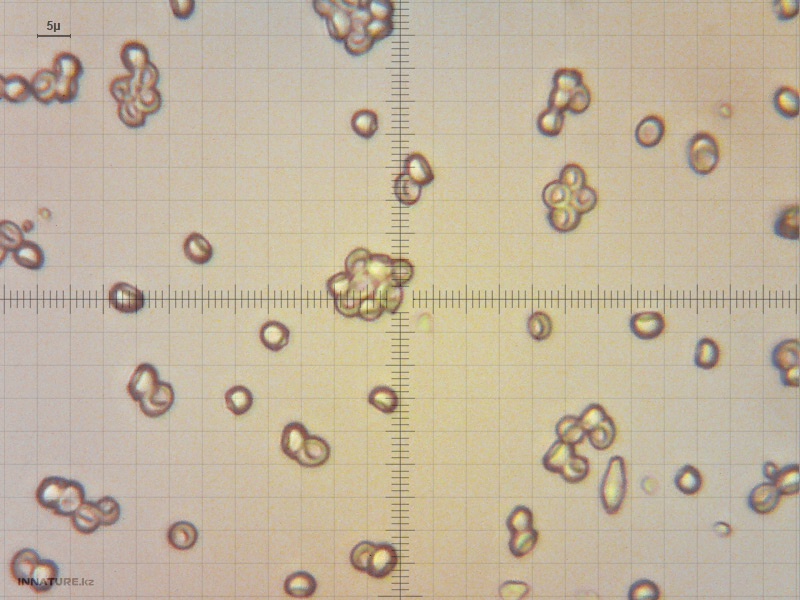 |
Plates: adherent or slightly descending, wide, frequent, rather thick, white or light yellowish.
Leg: 4-10 x 1.5-2.5 cm, often eccentric, cylindrical, solid, longitudinally fibrous, whitish
Pulp: thick, dense, white, sourish, with a flour smell.
Spores: 5-6 x 4 microns, spherical or broadly ovate, smooth.
Spore powder: white.
Habitat: grows on living trunks, deadwood and hardwood stumps in forests and parks.
Season: bears fruit from August to October.
Edible: Medium quality edible mushroom.
Distribution in Kazakhstan: found at the base of a live birch near Lake Zhukey in Akmola region.
Habitat: Russia, Belarus, West. Europe, East. Asia, North. America.
Gypsizigus elm in the photos:
Description of elm gypsygus
The diameter of the cap varies from 5 to 8 centimeters, but there are quite large specimens, the diameter of the caps of which reaches 15 centimeters. Young mushrooms have convex caps with curled edges. Droplets of moisture collect at the edges.
With age, the shape of the cap becomes convex-outstretched, sometimes there is a blunt tubercle or, conversely, a small depression. The cap is whitish, slightly yellowish, pale yellow with marbled, watery spots, and some specimens are pale brown in color.
The length of the leg is 5-8 centimeters, sometimes it can grow up to 10 centimeters, its diameter is 1-1.5 centimeters. The leg is most often central, sometimes it is curved, at the base it is expanded. The structure of the stem is longitudinal fibrous. Some mushrooms have pubescence at the base of the stem.

The leg is hollow inside. The color is whitish or pale fawn with a slight bloom. If you touch the leg, it turns yellow.
The pulp is firm, watery, grayish or slightly yellowish in color. The pulp has a damp smell. Elliptical or spherical spores.
Places of growth of elm hypsizigus
These mushrooms grow in deciduous and mixed forests. They can be found in the early autumn and until the second half of October. The harvest time is in September. They grow in bunches or singly.
Gypsizigus elm is a parasite fungus, it causes white rot in deciduous trees, on the roots of which it grows. These fungi parasitize on birch, elm, aspen, and can also be found on stumps.

Elm hypsizigus are unable to carry out the synthesis of organic substances themselves, since they are a heterotrophic species. They get carbon from the roots of higher plants, thus replenishing their vitality.
Taste qualities of elm gypsygus
Gypsizigus elm is not very well known in our country. This mushroom has a fairly average taste. They can be used fresh, pickled and salted, but boil them for 20 minutes beforehand. It is allowed to add these mushrooms fresh as an addition to the main courses. They can be pickled and salted. The pulp at the legs is fibrous-rubber.
Gypsizigus elm go well with fish and meat dishes. When fried in butter, they become very tasty.

The healing properties of elm gypsigus
These mushrooms have excellent medicinal properties. They contain a balanced amount of copper, iron, vitamins B2, D, potassium and pantothenic acid. The elm gypsygus contains a large amount of fiber, so these mushrooms can be used in various diets and to improve metabolism.
Gypsizigus elm is used in the treatment of asthma, diabetes, anemia. They stabilize blood pressure and normalize the work of the cardiovascular system. They enhance immunity, they create a barrier against viruses, fungi, bacteria and carcinogenic effects.

Evaluation of taste, medicinal properties, benefits and possible harm
Oyster mushroom is an edible mushroom. Taste is rated 4 points out of 5. It is not recommended to consume large quantities. With excessive consumption, a feeling of heaviness in the stomach is possible.
Elm lyophyllum has medicinal properties. Fruit bodies contain mineral salts, vitamins, 18 amino acids. The enzymes amylase and lipase, which are part of the mushrooms, contribute to weight loss and the breakdown of fats. Saturate the human body with fiber and glycogen.
Oyster mushrooms are an effective remedy for stomach ulcers.Juice is squeezed out of the mushrooms, a few tablespoons are given to the patient on an empty stomach. The same treatment is carried out for gastritis. Rowing juice improves peristalsis, heals wounds, relieves inflammation.
Use
The edible forest mushroom is very popular in cooking. Various recipes suggest using gypsygus in salads and soups, main courses and side dishes, in baking fillings. Also, the elm row is pickled and salted, this allows you to preserve useful properties for a long time.
Before any preparation, the gypsygus must be additionally prepared for use. Fresh caps are cleaned, washed in cold water and boiled for at least 20 minutes, processing helps to improve the taste.
Advice! It is better to cut ilm rows with wide hats into small pieces before processing. Small fruiting bodies can be boiled whole.
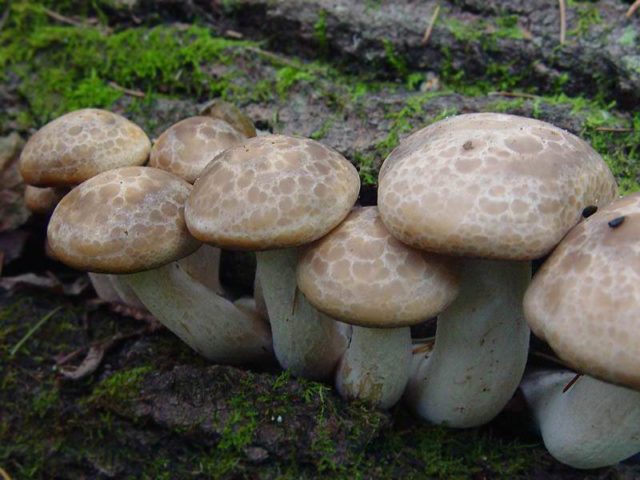
Lyophillum shimeji
Hon-shimeji
Until recently, it was believed that Shimeji Lyophyllum (Lyophyllum shimeji) is distributed only in a limited area covering the pine forests of Japan and parts of the Far East. At the same time, there was a separate species, Lyophyllum fumosum (L. smoky gray), associated with forests, especially conifers, some sources even described it as a mycorrhizal forming agent with pine or spruce, outwardly very similar to L.decastes and L.shimeji. Recent molecular studies have shown that no such separate species exists, and all finds classified as L. fumosum are either L.decastes (more commonly) or L. shimeji (Lyophillum simeji) (less commonly, in pine forests). Thus, today (2018), the species L.fumosum has been abolished, and is considered a synonym for L.decastes, significantly expanding the habitat of the latter, almost to “anywhere”. Well, L.shimeji, as it turned out, grows not only in Japan and the Far East, but is widespread throughout the boreal zone from Scandinavia to Japan, and, in some places, is found in pine forests of the temperate climatic zone. It differs from L.decastes only in larger fruit bodies with thicker legs, growth in small aggregates or separately, binding to dry pine forests, and at the molecular level.
Description
Hat: 4 - 7 centimeters. In youth, it is convex, with a pronounced curved edge. With age it evens out, becomes slightly convex or practically spread, in the center of the cap, a pronounced wide, low tubercle is almost always preserved. The skin of the cap is slightly matte, smooth. The color range - in gray and brownish tones, from light grayish-brown to dirty gray, can acquire yellowish-gray shades. On the cap, dark hygrophane spots and radial stripes are often clearly distinguishable; sometimes, a small hygrophane pattern in the form of a "mesh" can be present.
Plates: frequent, narrow. Loose or slightly adherent. In young specimens, white, later darken to beige or grayish.
Leg: 3 - 5 centimeters in height and up to one and a half centimeters in diameter, cylindrical. White or grayish. The surface is smooth, can be silky or fibrous to the touch. In the growths formed by mushrooms, the legs are firmly attached to each other.
Ring, bedspread, volva: none.
Flesh: firm, white, slightly grayish in the stem, firm. Does not change color at cut and break.
Smell and taste: pleasant, slightly nutty taste.
Spore powder: white. Spores: round to broadly ellipsoid. Smooth, colorless, hyaline or with fine-grained intracellular content, weakly amyloid. With a large spread in size, 5.2 - 7.4 x 5.0 - 6.5 microns.
Season and distribution
Active fruiting occurs in August - September. Lyophyllum shimeji grows in small aggregates and groups, rarely singly. Distributed throughout Eurasia from the Japanese archipelago to Scandinavia.
Similar types and differences from them
Crowded lyophyllum (Lyophyllum decastes) also grows in aggregates, but these aggregates consist of a much larger amount of fruit chalk.Prefers deciduous forests. The fruiting period is from July to October. Lyophyllum elm (Oyster mushroom, Hypsizygus ulmarius) is also considered very similar in appearance due to the presence of hygrophane rounded spots on the cap. In oyster mushrooms, fruiting bodies with a more elongated stem and the color of the cap are generally lighter than in Lyophillum simeji
However, these external differences are not so fundamental if we pay attention to the environment. Oyster mushroom does not grow on soil, it grows exclusively on dead wood of deciduous trees: on stumps and wood residues immersed in the soil
Other information about the mushroom
The specific name "Shimeji" comes from the Japanese name for the species Hon-shimeji or Hon-shimejitake. But in fact, in Japan under the name "Shimeji" one can find on sale not only Lyophyllum shimeji, but also, for example, another lyophillum actively cultivated there, elm.
Mushroom photo Lyophillum shimeji from questions in recognition:
Growing at home and in the country
It is profitable to breed oyster mushrooms at home. Mushrooms do well on any hardwood (freshly cut) trees. If the wood is soft, then the fruits appear quickly, but the yield is low. Hard breeds will delight you with a rich harvest, but the mycelium will grow more slowly.
Mycelium prices start at $ 2. Before planting, the trunk is cut into logs (30–40 cm in diameter, 30–35 cm long). If the bars are less than the indicated sizes, then fewer mushrooms will be born. There are several ways of planting, consider the simplest and most convenient.
Progress:
- Add mycelium (no more than 100 g) under the base of the bar.
- Bury the logs in the ground, 10–12 cm deep. The distance between them should be from 30 cm to 0.5 m.
- Inoculate in late spring. The crop can be harvested in the fall.
Taste and color
This mushroom is not well known in our country, its taste is rather average. In order to cook, boil for 15 to 20 minutes. It is allowed to use fresh, as an addition to the second course, you can salt, pickle. The legs have fiber-rubber pulp. Excellent combination with meat and fish dishes, gets excellent taste when fried in butter. It has excellent medicinal properties, contains the optimal amount of iron, copper, potassium, Vitamins B2, D, pantothenic acid. Due to the fact that it contains a large amount of fiber, it can be used in diets, improving metabolism. Helps in the treatment of anemia, stabilizes blood pressure, treats asthma and diabetes, stabilizes the cardiovascular system. This mushroom will not only increase the tone of the body, but also create a barrier against viral, bactericidal, fungal and carcinogenic effects by increasing the function of the immune system.
Definitioner
- Basidia (Basidia)
-
Lat. Basidia. A specialized structure of sexual reproduction in fungi, inherent only in Basidiomycetes. Basidia are terminal (end) elements of hyphae of various shapes and sizes, on which spores develop exogenously (outside).
Basidia are diverse in structure and method of attachment to hyphae.
According to the position relative to the axis of the hypha, to which they are attached, three types of basidia are distinguished:
Apical basidia are formed from the terminal cell of the hypha and are located parallel to its axis.
Pleurobasidia are formed from lateral processes and are located perpendicular to the axis of the hypha, which continues to grow and can form new processes with basidia.
Subasidia are formed from a lateral process, turned perpendicular to the axis of the hypha, which, after the formation of one basidium, stops its growth.
Based on morphology:
Holobasidia - unicellular basidia, not divided by septa (see Fig. A, D.).
Phragmobasidia are divided by transverse or vertical septa, usually into four cells (see Fig. B, C).
By type of development:
Heterobasidia consists of two parts - hypobasidia and epibasidia developing from it, with or without partitions (see Fig. C, B) (see Fig. D).
Homobasidia is not divided into hypo- and epibasidia and in all cases is considered holobasidia (Fig. A).
Basidia is the place of karyogamy, meiosis and the formation of basidiospores. Homobasidia, as a rule, is not functionally divided, and meiosis follows karyogamy in it. However, basidia can be divided into probasidia - the site of karyogamy and metabasidia - the site of meiosis. Probasidium is often a dormant spore, for example in rust fungi. In such cases, probazidia grows with metabasidia, in which meiosis occurs and on which basidiospores are formed (see Fig. E).

See Karyogamy, Meiosis, Gifa.
- Pileipellis
-
Lat. Pileipellis, skin - differentiated surface layer of the cap of agaricoid basidiomycetes. The structure of the skin in most cases differs from the inner flesh of the cap and may have a different structure. The structural features of pileipellis are often used as diagnostic features in descriptions of fungi species.
According to their structure, they are divided into four main types: cutis, trichoderma, hymeniderma and epithelium.
See Agaricoid fungi, Basidiomycete, Cutis, Trichoderma, Gimeniderm, Epithelium.
- Amyloid (Amyloid structure)
-
The structure is called amyloid if from Melzer's reagent (solution of 0.5 g of crystalline iodine + 1.5 g of potassium iodide + 20 ml of chloral hydrate + 20 ml of distilled water) turns blue, violet, sometimes almost black.
See Dextrinoid structure.
Benefits and harm to the body
Eating gypsygus in food can provide benefits to human health. The elm ryadovka contains important valuable substances, namely:
- polysaccharides;
- basic vitamins A, C, D and B;
- 18 essential amino acids;
- mineral salts;
- digestive enzymes - lipase and amylase;
- glycogen and fiber.
Correctly processed gypsygus increases the immune resistance and supplies the body with a large amount of plant protein.
Namely:
- accelerates the breakdown of fats;
- helps to get rid of excess weight;
- helps to relieve the inflammatory process with stomach ulcers;
- improves peristalsis;
- has a beneficial effect on the condition of the skin.
Important! Ilmovaya ryadovka has pronounced anti-cancer properties, the use of gypsygus prevents the development of oncological diseases
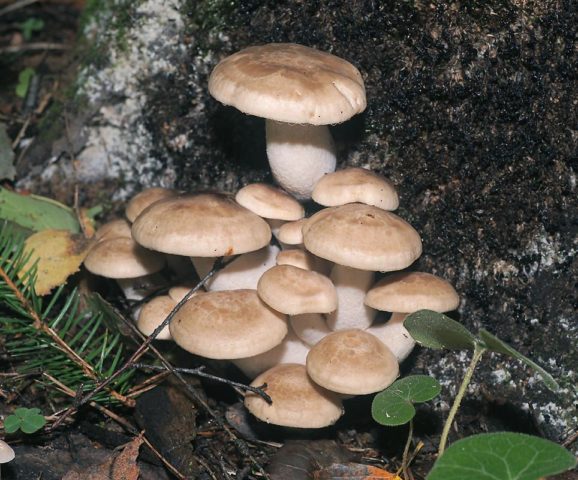
At the same time, the elm ryadovka can cause serious harm to the body. A protein-rich product is not recommended for sluggish intestines - gypsygus can cause constipation. Also, it is better to refuse ryadovka with pancreatitis and gastritis with low acidity.
Poisoning with an improperly prepared mushroom is a great danger. Therefore, it is forbidden to eat elm ryadovka for pregnant women and children under the age of 7, for them the consequences of intoxication can be especially serious.

